[SID2022] NANOSYS Booth in Display Week
NANOSYS는 디스플레이용 퀀텀 닷을 생산하는 기업입니다.
Quantum Dot Enhancement Film(QDEF) 빛을 더 밝고 화려하게 만드는 광학 필름입니다.
다양한 기업들의 QD 디스플레이를 비교할 수 있는 공간이 마련되어 있었습니다.
NANOSYS는 디스플레이용 퀀텀 닷을 생산하는 기업입니다.
Quantum Dot Enhancement Film(QDEF) 빛을 더 밝고 화려하게 만드는 광학 필름입니다.
다양한 기업들의 QD 디스플레이를 비교할 수 있는 공간이 마련되어 있었습니다.
■ Investment cost comparison and analysis for WRGB OLED, solution processed OLED and QD-OLED
■ Total OLED process equipment is expected to form a market of US$ 58.8 billion from 2018 to 2022, and inspection equipment market is estimated as US$ 8.4 billion
In the premium TV market, the market share of OLED TVs is steadily rising, and the number of OLED TV camps is gradually increasing. OLED TV adopts color filter to WRGB OLED, and currently LG Display only mass produces the OLED panels.
On the other hand, Samsung Display is developing QD-OLED (blue OLED + quantum dot color filter) to compete with WRGB OLED in the premium TV market. Blue OLED is a technology in which the blue light emitted from OLED passes through a quantum dot layer and a color filter to represent red and green colors.
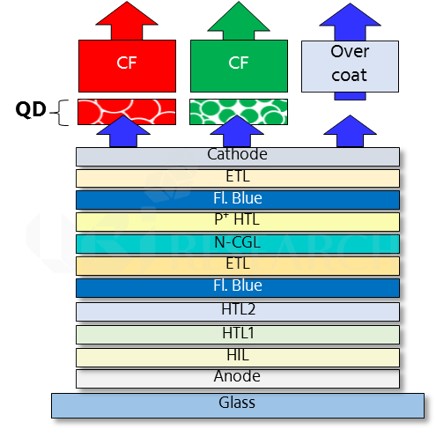
<Expected structure of QD-OLED>
UBI Research analyzed the structure and investment amount of WRGB OLED and QD-OLED, which are the latest issues, in the‘AMOLED Manufacturing and Inspection Equipment Industry Report’ published on June 6. In addition, the investment amount of the solution process OLED, which has got the industry attention due to its possible implementation of real RGB in large-area OLED, is also analyzed and compared.
As a result of analyzing the equipment investment cost based on the 8th generation 26K, the QD-OLED investment cost is 3% higher than WRGB OLED and the investment cost of solution process OLED is 19% less than that of WRGB OLED.
In the QD-OLED investment cost, it is reflected that QD color filter is separately formed and its laminating process is added. For the analysis of solution processed OLED investment cost, color filter is excluded and ink-jet printer is applied instead of deposition equipment.
In addition, the report forecasts the overall OLED equipment market from 2018 to 2022. The total OLED overall equipment market is expected to reach US$ 106.7 billion from 2018 to 2022. The market for process equipment is projected as US$ 58.8 billion and inspection equipment market is to be US$ 8.4 billion.
최근 premium TV 시장은 OLED TV의 점유율이 지속적으로 상승하고 있으며 OLED TV 진영도 꾸준히 증가하고 있는 추세다. OLED TV는 WRGB OLED에 color filter를 적용한 구조로써, 현재 LG Display만이 유일하게 OLED panel을 양산하고 있다.
이에 Samsung Display에서는 premium TV 시장에서 WRGB OLED에 대항하기 위해 blue OLED + quantum dot color filter(이하 QD-OLED)를 개발하고 있는 것으로 알려졌다. Blue OLED는 OLED에서 발광 된 청색광이 quantum dot층과 color filter를 통과해 red와 green 색을 나타내는 기술이다.

<QD-OLED 예상 구조>
유비리서치는 지난 6일 발간한 ‘AMOLED Manufacturing and Inspection Equipment Industry Report’에서 최근 이슈가 되고 있는 WRGB OLED와 QD-OLED의 구조와 투자 금액을 분석했다. 뿐만 아니라, 대면적 OLED에서 real RGB를 구현할 수 있어 주목받고 있는 solution process OLED의 투자 금액도 함께 분석하여 비교했다.
8세대 26K 기준으로 장비 신규 투자비를 분석한 결과, QD-OLED 투자비는 WRGB OLED에 비해 3%가 많고 solution process OLED는 WRGB OLED에 비해 19% 적은 것으로 조사되었다.
QD-OLED 투자비에서는 QD color filter가 따로 형성되고 이를 합착하는 공정이 추가된 내용이 반영되었으며, solution process OLED 투자비에서는 color filter가 제거되고 증착 장비 대신 ink-jet printer가 투입된 내용이 반영되었다.
이 밖에 본 보고서에서는 2018년부터 2022년까지 OLED 전체 장비 시장도 예상하였다. 2018년부터 2022년까지 OLED 전체 장비 시장은 US$ 106.7 billion을 형성할 것으로 전망되며, 공정 장비는 그 중 US$ 58.8 billion, 검사 장비는 US$ 8.4 billion의 시장을 형성할 것으로 예상된다.

<2018년~2022년 장비별 전체 시장 점유율 전망>
In the premium TV market, the share of OLED TVs is steadily increasing, and the price gap with LCD is gradually decreasing. As a result, LCD TV (QD-LCD TV) companies using quantum dot technology are sluggish in the premium TV market.
OLED TV uses white OLED and OLED panel with color filter (hereafter referred to as WRGB OLED), which is mass-produced only by LG Display.
Samsung Display is known to actively develop blue OLED + QDCF (blue OLED), which is one of the technologies to compete with WRGB OLED in the premium TV market.
UBI Research predicted that Samsung Display would implement blue OLED + QDCF with top emission method and it would be more advantageous to implement 8K and BT 2020 than WRGB in its ‘2018 OLED Material Industry Report’ published on April 18.
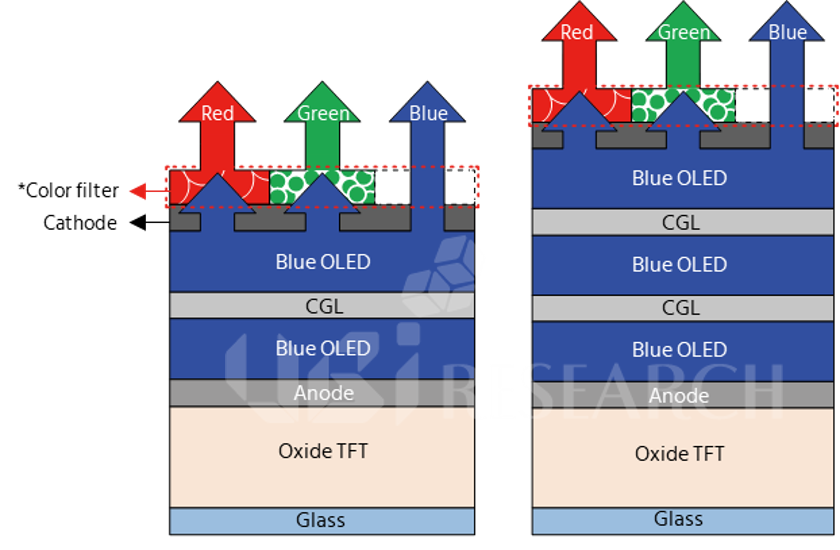
<Expected stack structure for Blue OLED, 2stack (left), 3stack (right), 2018 AMOLED emitting materials Report, UBI Research>
8K and BT2020 are to be adopted for the premium TVs. Also, the development of blue materials is expected to be aggressively progressed according to Samsung Display’s development of blue OLED. The blue material currently used in OLED is a fluorescent material that is insufficient in the efficiency and lifetime than phosphorescent material used in red and green. Blue phosphorescent materials have been developed continuously but they have not been applied to mass production due to the scarcity of materials and technical barriers. Therefore, blue fluorescent materials are stacked two or more times to improve efficiency and lifetime for large area OLED, and blue OLED is expected to use more than 2 stack structure.
With this trend, the market for blue emitting materials is expected to continue to grow. In 2017, blue materials (host and dopant) formed market of US$ 70 million. According to the 2018 AMOLED emitting material market track published by UBI Research, blue material is expected to grow at an average annual rate of 32% by 2022 and reach US $ 272 million sales.
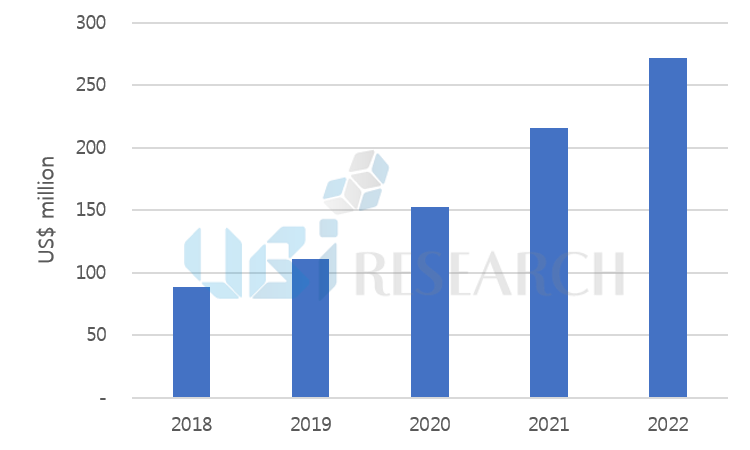
<Blue material (host and dopant) market forecast, 2018 AMOLED emitting materials Market track>
프리미엄 TV 시장에서 OLED TV의 점유율이 지속적으로 증가하고 있으며, LCD와의 가격 격차도 점차 감소하고 있는 추세로 quantum dot 기술을 적용한 LCD TV(QD-LCD TV)업체들이 프리미엄 TV시장에서 주춤하고 있는 상황이다.
OLED TV는 white OLED와 color filter를 적용한 OLED panel을 사용하고 있으며(이하 WRGB OLED) LG Display에서 유일하게 양산하고 있다.
삼성디스플레이에서는 프리미엄 TV시장에서 WRGB OLED에 대항하기 위한 기술 중 하나인 blue OLED + QDCF(이하 blue OLED)를 적극적으로 개발하고 있는 것으로 알려졌다.
유비리서치는 지난 18일 발간한 ‘2018 OLED 재료 산업 보고서’에서, 삼성디스플레이는 top emission 방식으로 blue OLED+QDCF를 구현할 것으로 예상했으며, 이에 따라 8K와 BT 2020을 구현하는데 WRGB 보다 유리할 것으로 분석한 바 있다.

<Blue OLED 예상 스택 구조, 2stack (좌), 3stack (우), 2018 AMOLED emitting materials Report, UBI Research>
TV의 트랜드가 8K, BT2020으로 진행되고 있으며, 삼성디스플레이의 blue OLED 개발에 힘입어 blue materials에 대한 개발도 적극적으로 진행될 전망이다. 현재 OLED에 사용되고 있는 blue재료는 형광물질로서 red와 green에 사용되는 인광물질보다 효율과 수명이 부족하다. Blue 인광재료 개발도 지속적으로 진행되 오고 있지만 재료의 희소성과 기술장벽으로 양산에 적용되지 못하고 있는 실정이다. 따라서 대면적 OLED panel에는 형광 blue 재료를 2번이상 적층하여 효율과 수명을 향상시키는 stack 구조를 적용하고 있으며, blue OLED도 2 stack 이상의 구조를 사용할 것으로 예상된다.
이러한 추세에 따라 blue 발광재료에 대한 시장도 지속적으로 성장할 것으로 예상된다. 2017년 blue 재료(host와 dopant)는 US$ 70 million의 시장을 기록했다. 유비리서치에서 발간한 2018 AMOLED emitting material market track에 따르면 blue 재료는 2022년 까지 연평균 32%로 성장하여 US$ 272 million의 규모가 될 것으로 전망했다.

<Blue 재료(host와 dopant) 시장전망, 2018 AMOLED emitting materials Market track>
Samsung Display selected blue OLED + QDCF (blue OLED) as next generation display technology following LCD TV, and started the necessary development.
Blue OLED is a technology, in which blue light emitted from blue OLED passes through a quantum dot color filter to represent red and green colors (b). The WRGB OLED used in OLED TV is a method in which white light passes through a color filter and implements RGB colors (a).
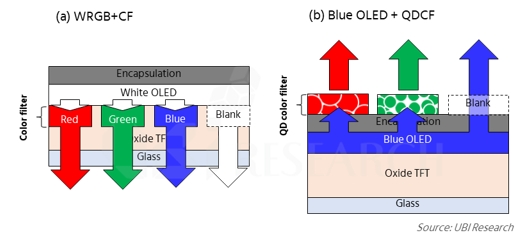
The ‘2018 OLED Materials Industry Report’ published by UBI Research on April 18 describes whether blue OLED, which Samsung Display has started to develop, can become TV OLED panels. The expected development direction and performance (efficiency and lifetime) of blue OLED + QDCF are analyzed. In particular, current status and development trends (fluorescence, phosphorescence, TADF) of blue emitting material, which is the core material of blue OLED, are covered.
Since blue OLED of Samsung Display is top emission type, the aperture ratio is increased by about 70% compared to the bottom emission, which emits light in the TFT direction, so that 8K resolution and high brightness are realized better than the conventional WRGB OLED. In addition, it is expected to reach BT. 2020, the UHD color standard, which was established by the International Telecommunication Union (ITU) in 2012, using QD material with high color reproduction rate as color filter.
In the future premium TV market, 8K and BT. 2020 are necessary conditions for display. WRGB OLED is also being actively developed to implement 8K and BT2020. Attention is focused on the impact of the development of blue OLED in the premium TV market led by WRGB OLED.
In addition, the report analyzes the market status and development trends of the related companies, including overall technology development directions and key issues for new materials such as soluble OLED materials and near IR materials.
삼성디스플레이가 LCD TV를 이을 차세대 디스플레이 기술로서 blue OLED + QDCF(이하 blue OLED)를 선정하고 개발에 착수 했다.
Blue OLED는 OLED에서 발광 된 청색광이 quantum dot층과 color filter를 통과해 red와 green 색을 나타내는 기술이다(b). OLED TV에 사용중인 WRGB OLED는 백색광이 칼라필터를 통과해 RGB 색상을 구현하는 방식이다(a).

유비리서치가 지난 18일 발간한 ‘2018 OLED 발광재료 산업 보고서’는 삼성디스플레이가 개발에 착수한 blue OLED가 TV용 OLED 패널이 될 수 있는지를 분석하였다. blue OLED+QDCF의 예상 개발 방향과 기대되는 성능(효율과 수명)을 분석하였으며, 특히 blue OLED의 핵심 재료인 blue 발광재료의 현재 동향과 개발 상황(형광, 인광, TADF)을 다루고 있다.
삼성디스플레이의 blue OLED는 top emission 방식이기 때문에 TFT 방향으로 빛이 방출되는 bottom emission 대비 개구율이 약 70% 증가되어 8K 해상도와 고휘도 구현이 기존 WRGB OLED보다 유리하다. 또한, 색재현율이 높은 QD 재료를 color filter로 사용하여 2012년 국제 전기 통신 연합인 International Telecommunication Union(ITU)가 제정한 UHD 색 규격인 BT. 2020에 도달이 가능할 것으로 예상된다.
추후 프리미엄 TV 시장에서 8K와 BT2020은 display가 갖추어야할 필수조건으로 WRGB OLED도 8K와 BT2020을 구현하기 위해 적극적으로 개발 중에 있다. Blue OLED의 개발이 WRGB OLED가 주도하고 있는 프리미엄 TV시장에서 앞으로 어떤 영향을 미칠지 기대된다.
그 밖에도 soluble OLED 재료와 near IR 재료 등 신규 재료들에 대한 전반적인 기술 개발 동향과 핵심 이슈를 다루었다.
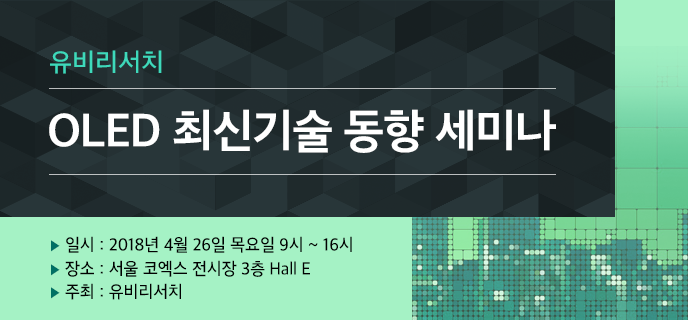
유비산업리서치(http://www.ubiresearch.co.kr/, 대표 이충훈)는 오는 4월 26일(목) 서울 코엑스 전시장 3층 Hall E에서 ‘OLED 최신기술 동향 세미나’를 개최 할 예정이다.
CES2018에서 삼성디스플레이는 blue OLED에 quantum dot와 color filter를 사용한 새로운 구조의 OLED 패널을 공개했다. 이 구조의 OLED는 삼성디스플레이의 현재 사업인 모바일용 디스플레이가 아닌 TV용 대면적 OLED제작을 위한 패널이다.
삼성디스플레이가 blue-OLED 개발에 착수하기 위해 대규모 개발팀을 신설한 것은 LG디스플레이가 독보적으로 차지하고 있는 대면적 OLED 패널 사업에 진입하기 위한 사전 포석 단계로 볼 수 있다. 이번 세미나에서는 삼성디스플레이가 최근 공개한 계획인 blue-OLED의 사업화 가능성과 LG 디스플레이의 WRGB OLED와 비교하여 어떤 기술인지를 집중적으로 분석해 보고자 한다. 이를 위해 가장 중요한 해결 과제인blue OLED용 청색 발광 재료 개발 현황과 blue OLED용 quantum dot 재료 개발 현황을 면밀히 분석하여 전망할 예정이다.
또한 대면적 OLED 패널 이슈와 함께 모바일에서 새로운 Application에 대한 가능성으로 제시되고 있는 폴더블OLED개발 현황과 시장을 전망한다. 이를 통해 올초 계획인 2018년 연말 폴더블 OLED 스마트폰 출시와 관련한 다양한 예상이 가능할 것으로 기대한다.
그 이외에 또 다른 대면적 디스플레이 기술로서 이슈화되고 있는 solution processed OLED와 Micro LED등 차세대 디스플레이 기술 현황과 개발 이슈 사항 등을 다룰 예정이다.
이번 세미나는 빠르게 진화하는 디스플레이 시장의 기술 트랜드를 예측하여 업체들의 시장현황과 기술 변화를 파악하는데 큰 도움이 될 것으로 기대하고 있다.
금번 세미나의 세부 주제들로는 △’ OLED 스마트폰과 폴더블 폰 시장 전망’ △’OLED TV 프리미엄 시장 확대를 위한 핵심 기술 과제 – Solution Process OLED 가능성’ △ ‘폴딩 1R 구현을 위한 핵심기술 과제 – TFT, 기판, 인캡등’ △’BLUE OLED + QDCF TV 를 위한 핵심 기술 과제 : QD재료’ △’OLED TV용 Oxide TFT’ △ ‘OLED 청색 발광 재료 기술 동향 및 전망’ △ ‘Micro LED 프리미엄 TV 제조공정을 위한 핵심 기술 과제 등의 주제 발표가 예정되어 있다.
Samsung Electronics is currently occupying the premium TV market with QD-LCD TVs, which use ‘PL-QD (photoluminescence quantum dot) technology’. This technology has a mechanism in which the material stimulated by external light re-emits light.
The operating profit of the consumer electronics division (CE), which controls QD-LCD TVs, fell more than Korean won 1 trillion in last year and the operating profit ratio was only 3.6%.
On the other hand, LG Electronics’ HE business division achieved a record operating profit of Korean won 1,566.7 billion and an operating margin of 8.1% through OLED TV. Sony also turned its operating profit into a surplus by quickly taking over the premium TV market with OLED TV.
OLED TV has had a positive effect in driving corporate sales growth.
Samsung Electronics has been developing EL-QLED, with EL-QD (electroluminescence quantum dot) technology, to increase its market share in the premium TV market. However, efficacy, lifetime and mass production technology of quantum dot, which is the material of QLED, is not yet secured.
Recently, QD-OLED TV technology, which uses blue OLED as a light source and that implements red and green colors through a quantum dot color filter (QDCF), is attracting attention.
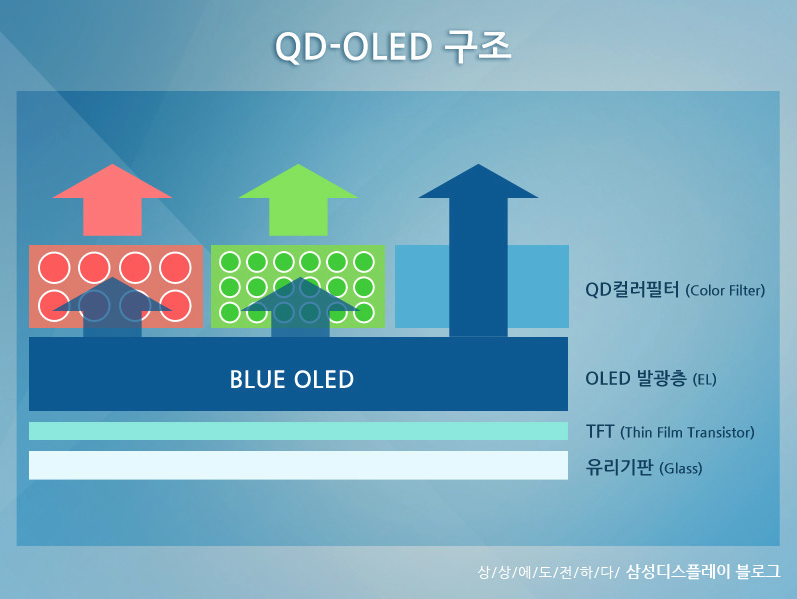
<Expected structure for QD-OLED, Source: Samsung Display Blog>
By using QDCF, it is possible to easily make desired colors by adjusting the size of the QD material and improve the color reproduction rate. This is because the color gamut is enlarged to BT2020, so it is close to natural color and it is possible to deliver vivid picture quality more clearly. In addition, QD-OLED TV has a top emission structure, which makes it easy to secure the aperture ratio, thereby improving resolution and screen uniformity.
However, in QD-OLED TV, there are various problems to be solved such as lifetime and efficiency of blue OLED, and technology of ink-jet printing process. Given that the industry is still in the early stages of reviewing the business possibility, QD-OLED TVs are expected to go into mass production after 2020.
Attention is focused on the QD-OLED TV’s entry into the premium TV market and its impact.
삼성전자는 현재 ‘PL-QD(photoluminescence quantum dot)기술’ 적용한 QD-LCD TV로 프리미엄 TV시장을 점유하고 있다. 이 기술은 외부 광에 의해 자극된 물질이 다시 빛을 내는 메커니즘을 갖는다.
이러한 QD-LCD TV를 관할하는 가전부문(CE)의 영업이익은 지난해 1조 이상 줄었으며, 영업 이익률은 3.6%에 그쳤다.
반면, LG전자의 HE사업본부는 OLED TV를 통해 영업이익 지난해 1조 5,667억원, 영업이익률 8.1%로 역대 최고치를 달성하였다. SONY 또한 OLED TV를 앞세워 빠르게 프리미엄 TV 시장을 점유함으로써 영업이익을 흑자로 전환시켰다.
OLED TV가 기업의 매출 상승을 이끄는 긍정적인 효과를 낳은 셈이다.
이에 삼성전자는 프리미엄 TV시장에서의 점유율을 높이고자 EL-QD(electroluminescence quantum dot) 기술을 적용한 진정한 의미의 EL-QLED를 개발에 박차고 있으나, 여전히 QLED의 재료인 quantum dot의 효율과 수명, 양산기술은 아직 확보되지 않은 것으로 알려졌다.
최근 blue OLED를 광원으로 사용하고 그 빛이 QDCF(quantum dot color filter)를 통과하여 red와 green 색을 구현하는 QD-OLED TV 기술이 주목받고 있다.

<예상되는 QD-OLED 구조, 출처:삼성디스플레이블로그>
QDCF를 이용하면 QD재료의 크기를 조절하여 원하는 색을 쉽게 만들 수 있으며, 색 재현율을 향상시킬 수 있다. 이는 색 영역을 BT2020까지 확대하여 자연색에 가까우며 더 선명하게 생생한 화질을 전달할 수 있을 것으로 보인다. 또한, QD-OLED TV는 전면 발광구조로 개구율 확보가 용이해 해상도와 화면 균일도를 향상시킬 수 있다.
그러나 QD-OLED TV에는 blue OLED의 수명과 효율, ink-jet printing 공정기술 확보 등 풀어나가야 할 여러가지 문제점들이 존재하고 있다. 이에 대해 관련 업계에서는 아직 사업 검토가 초기 국면임을 감안할 때, QD-OLED TV의 양산 시기는 2020년은 넘어야 할 것으로 전망하고 있다.
QD-OLED TV가 프리미엄 TV시장에 진입하여 어떠한 지각변동을 불어 일으킬 것인지 귀추가 주목된다.
The micro LED, QLED and hologram, which are referred to as the next generation displays, were presented at the seminar entitled ‘Recent Trends in Display and Vehicle Display Technology’ hosted by UBI Research on the 14th.
Under the theme ‘Technical Issues of micro LED Display and Market Trend’, professor Moon Dae-gyu of Soonchunhyang University said, “Micro LED can be realized in high resolution and it is easy to implement curved display or flexible display because there is no limit of panel shape and size” He added “When applying micro LED to a display, high resolution is feasible even on a small substrate size, so that it can be applied to VR, etc.” and expected “When applied to a public display, it will be able to escape from the method of tiling many display panels”. However, there remain some technical problems such as the problem of transferring and connecting millions of LED chips quickly and accurately, the deviation problem of color and luminous efficiency between LED chips, and the technical problem of implementing an active matrix for the application of a display.
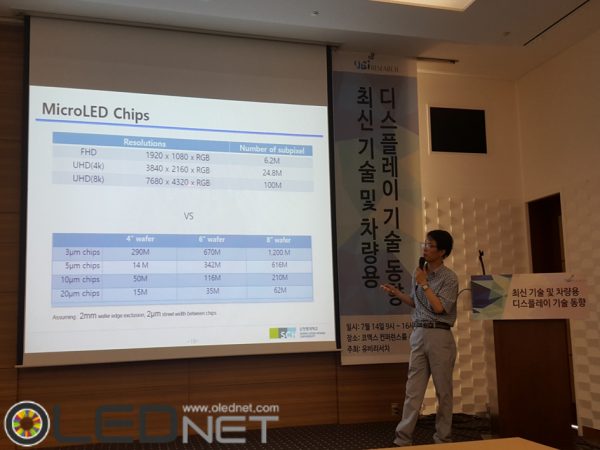
<Professor Moon Dae-gyu of Soonchunhyang University>
Next, Dr. Hwang Do-Kyung of Korea Institute of Science and Technology(KIST), Dr. Bae Wan-ki, senior researcher of KIST, and Dr. Oh Min-Suk of Korea Electronics Technology Institute(KETI) announced the manufacturing principle of quantum dot and the possibility of self-emitting QLED using it. Dr. Hwang said, “The quantum dot has the advantage of not only color change depending on the size and but also narrow half width.” “Self-emitting QLED can display higher color purity than OLED.” he added.
Dr. Bae expected “If research is carried out on an enterprise scale, the speed of technology development will increase more rapidly.” saying that “At present, the efficiency of quantum dot devices is continuously improving, but the life span is insufficient compared to OLED.”
“We need the next generation display technology to follow the LCD and OLED,” said Dr. Oh Min-Seok of Korea Electronics Technology Institute(KETI). He added “QLED is attracting much attention as a next-generation display, but there remain such issues as too much focus on the development of emitting devices, the lack of solution process-related devices and technologies, and the non-cadmium-based high-efficiency blue light emitting devices”.
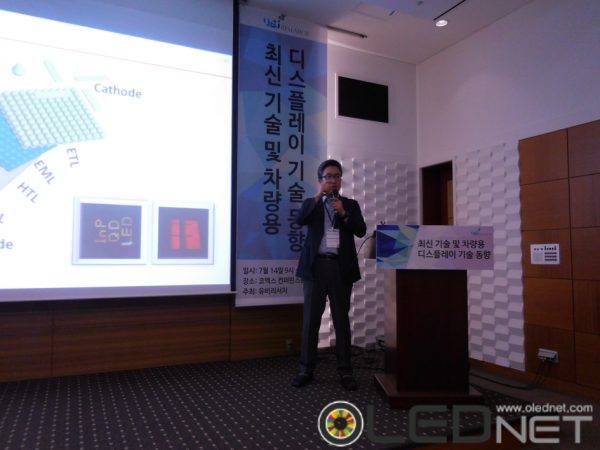
<Dr. Oh Min-Seok of Korea Electronics Technology Institute(KETI)>
As the last speaker, Kang, Hoon-Jong, team leader of Korea Electronics Technology Institute(KETI) explained the digital hologram technology and its application, and emphasized that a display panel capable of expressing the hologram is necessary to implement it. He said “We have a holographic printer or a microscope but there is no enough technology to apply it to TV”. Then, he closed his presentation saying “We need to develop a film for hologram first and then a functional design that can implement the screen.”
During the presentation about the next generation display, many of the speakers emphasized the importance of cooperation and participation among schools, research institutes and companies in order to overcome technical problems and realize them as actual displays. The display competition is expected to become even more intense in the future, as R&D in micro OLED, QLED, and hologram, which are considered as the next generation display, is concentrated
지난 14일 열린 유비리서치 주관 ‘최신 디스플레이 및 차량용 디스플레이 기술 동향’ 세미나에서 차세대 디스플레이로 언급되고 있는 micro LED와 QLED, hologram 등의 발표가 진행됐다.
순천향대학교의 문대규 교수는 ‘마이크로 LED 디스플레이의 기술 이슈와 시장 현황’을 주제로 하여 “micro LED는 고해상도 구현이 가능하고 패널의 모양과 사이즈의 제한이 없어 curved display나 flexible display 구현이 용이하다”라고 언급했다. 또한 “micro LED를 디스플레이에 적용 시 작은 기판 사이즈에서도 고해상도 구현이 가능하여 VR 등에 적용이 가능하다”며, “public display에 적용 시 기존에 다수의 디스플레이 패널을 타일링 하던 방식에서 벗어날 수 있을 것”으로 전망했다. 다만, 수백만개의 LED chip을 빠르고 정확하게 이송하여 접합하는 문제와 LED chip간의 색과 광 효율 편차 문제, 디스플레이 적용 시 active matrix 구현 문제 등의 기술적 문제가 남아있다고 밝혔다.

<순천향대학교 문대규 교수>
이어서 황도경 한국과학기술연구원 박사와 배완기 한국과학기술연구원 선임연구원, 오민석 전자부품연구원 박사는 quantum dot의 제조 원리와 이를 이용한 자발광 QLED의 가능성을 발표했다. 황도경 박사는 “quantum dot은 크기에 따라 색 변형이 자유롭고 반치폭이 좁다는 장점이 있다”며, “자발광 QLED는 OLED에 비해 색순도가 높은 디스플레이 구현이 가능하다”고 언급했다.
배완기 선임연구원은 “현재 quantum dot 소자의 효율은 지속적으로 향상이 되고 있으나 수명은 OLED 대비 부족한 실정이다”라며, “기업 규모로 연구가 진행 되면 기술의 발전 속도가 더 빠르게 증가 할 것”으로 전망했다.
오민석 전자부품연구원 박사는 “LCD와 OLED의 뒤를 이을 차세대 디스플레이 기술이 필요하다”며 “현재 QLED가 차세대 디스플레이로 많은 관심을 받고 있지만, 발광소재 개발에만 집중하는 문제와 용액 공정 관련 소재와 기술 부족, 비 카드뮴계 고효율 블루 발광 소재 개발 등의 이슈가 있다”고 언급했다.

<오민석 전자부품연구원 박사>
마지막 순서로 강훈종 전자부품연구원 팀장이 digital hologram 기술과 응용 방안을 설명하며 hologram을 구현하기 위해서는 이를 표현할 수 있는 디스플레이 패널이 반드시 필요하다고 강조했다. 또한, “현재 홀로그래픽 프린터나 현미경이 있지만 TV에 적용하기에는 아직 기술이 부족하다”며 “hologram용 film을 먼저 개발하고 그 후 화면을 구현할 수 있는 functional 설계가 필요하다”고 발표를 마쳤다.
차세대 디스플레이 발표가 진행 되는 동안 다수의 연사자들은 기술적인 문제 극복과 실제 디스플레이로 구현하기 위해 학교와 연구소, 기업들 간의 협동과 참여가 중요하다고 강조했다. 대표적인 차세대 디스플레이로 언급되는 Micro OLED와 QLED, hologram의 연구 개발이 집중되면서 앞으로 시장 선점을 위한 디스플레이 경쟁이 더욱 더 치열해질 전망이다.
According to the industry source dated Nov. 21, it was confirmed that Samsung Electronics was selected as a preferred bidder participating in the acquisition battle for ‘QD Vision’. The amount of acquisition proposed by Samsung Electronics is U$70million, and the industry expects that the final takeover will be agreed no later than the next week.
Quantum dot is the materials whose implementing color is different according to the size, and Samsung Electronics is introducing SUHD TV to the premium TV market, which improves the color reproduction rate by applying quantum dot sheet to LCD BLU for the first time in the world, and Chinese companies are actively launching the products.
‘QD Vision’ established by the researchers from MIT, is a specialized enterprise with high technology in the field of cadmium-based quantum dot and it is introducing non-cadmium-based material, too, lately. The industry considers that the acquisition of ‘QD vision’ by Samsung Electronics is the cornerstone to accelerate the commercialization of QLED along with the expansion of the quantum-dot TV market.
Although QLED is highly anticipated to be available to realize the panel with high purity as it is less impacted by oxygen and moisture than OLED and as it has a narrow half width, very low efficiency and life time compared to OLED materials are mentioned as the problem, under its initial stage of development. Furthermore, cadmium used in the core of quantum dot is highly toxic carcinogen, so Cd-free materials are being developed by ‘QD Vision’, ‘Nanoco’, ‘Nanosquare’, etc., however, its performance is lower than Cd-base materials. Therefore, the industry expects that it will take at least 5 years for QLED to be applied to mass production.
In the meantime, related with this issue, in the ‘Market penetration possibility analysis and seminar for QLED and Solution Process OLED’ hosted by UB Research in last October, Professor Chang-hee Lee of Seoul National University mentioned that, “If large-scale investment and manpower would be input, it is likely to find the product in earlier time than expected, and there is a possibility that the entry barrier can be lowered due to its similar structure to OLED”
It is highly attended that whether the acquisition of ‘QD vision’ by Samsung Electronics can accelerate the commercialization of QLED by becoming the starting point of large-scale investment, and what effect would be influenced to the display industry.
21일 업계에 따르면 삼성전자는 최근 QD vision 인수전에 참여하여 우선협상 대상자로 선정 된 것으로 확인 됐다. 삼성전자가 제안한 인수금액은 7000만 달러로, 업계는 늦어도 다음 주 정도에 최종 인수에 합의 할 것으로 보고있다.
Quantum dot은 크기에 따라 구현하는 색이 다른 물질로, 삼성전자는 세계 최초로 LCD BLU에 quantum dot sheet를 적용하여 색재현율을 향상시킨 SUHD TV를 프리미엄 TV 시장에 선보이고 있으며, 중국업체들도 적극적으로 제품 출시를 하고 있다.
MIT 출신 연구자들이 설립한 QD vision은 카드뮴계 quantum dot 분야에서 기술력이 높은 전문 기업으로 최근에는 비카드뮴 소재도 선보이고 있다. 업계에서는 삼성전자의 QD vision 인수가 quantum dot TV 시장의 확대와 함께, QLED 상용화를 앞당기기 위한 초석으로 보고있다.
QLED는 OLED에 비해 산소와 수분의 영향이 적고, 반치폭이 좁아 고색순도의 패널 구현이 가능할 것으로 기대를 모으고 있지만, 개발 초기단계로 OLED 재료와 비교하여 매우 낮은 효율과 수명이 문제점으로 언급되고 있다. 또한 quantum dot 중심체에 쓰이는 카드뮴은 유독성이 강한 발암물질로, QD vision과 Nanoco, Nanosquare 등에서 Cd-free 물질을 개발 중이나 카드뮴 소재에 비해 성능이 낮다. 따라서 업계에서는 QLED가 양산에 적용되기까지는 최소 5년 이상 걸릴 것으로 예상하고 있다.
한편, 이와 관련해 서울대 이창희 교수는 지난 10월 유비산업리서치가 주관한 ‘QLED와 solution Process OLED 시장 진입 가능성 분석 및 세미나’에서 “대규모의 투자와 인력이 투입된다면 예상보다 이른 시기에 제품을 볼 수 있을 것으로 보이며, OLED와 구조가 비슷하여 진입 장벽이 낮아 질 가능성이 있다” 라고 언급했다.
삼성전자의 QD vision 인수가 대규모 투자의 시발점이 되어 QLED 상용화를 앞당길 수 있을지, 그리고 디스플레이 산업에 어떠한 영향을 미칠지 귀추가 주목되고 있다.
At ‘an analytical seminar on market entry potential of OLED and Solution Process OLED’ having been held in Seoul Small& Medium Business Center on last October 14th, Professor Lee Chang-hee of Seoul National University and Senior Researcher Bang Ji-won of Korea Institute of Ceramic Engineering and Technology shared opinions about current situations of QLED, development trends, and issues.

<Professor Lee Chang-hee of Seoul National University>
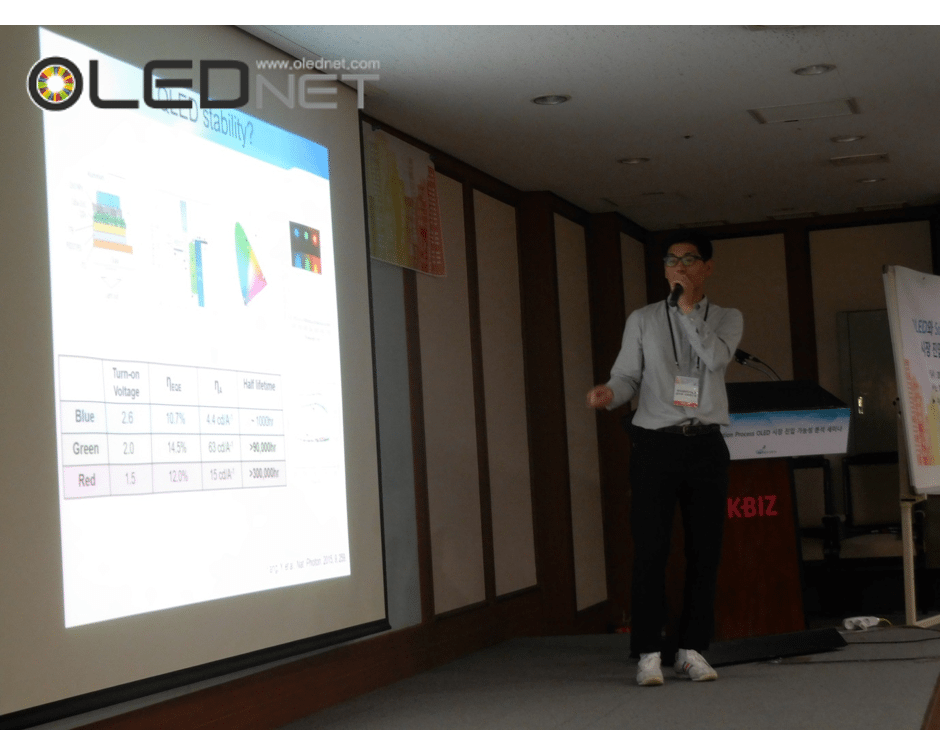
<Senior Researcher Bang Ji-won of Korea Institute of Ceramic Engineering and Technology>
Professor Lee Chang-hee said that QLED had excellent color purity because half-width of QLED was narrower than OLED by approximately 20~30nm, and disclosed a fact that QLED was favorable in color reproduction due to high levels of accuracy when manufacturing it, and efficiency of luminescence material reached to regular levels to the degree of catching up OLED. However, he stated technical difficulties of Cd-free QLED which did not use cadmium, a heavy metal, together with securing life stability of QD (Quantum Dot) luminescence materials, and emphasized that investment on QLED is the shortcut of commercialization by saying “The time of commercialization could be moved forward to 5 years or 3 years according to capital and manpower investing scales from the industry.”
Senior Researcher Bang Ji-won pronounced luminescence efficiency of light-emitting materials, stability, non-toxic QD, and approaches by various directions such as QD-LCD which applied QD CCL (Color Change Layer) to blue-LED BLU (Black Light Unit) by using QD, OLED which applied OD-CCL and C/F (Color Filter) to WOLED, OLED that applied QD CCL without C/F to blue-OLED were being progressed.
QLED-related academia discussed about the potential of OLED positively in this way, but CEO Lee Chung-hoon of UBi RESEARCH said “Development of WOLED will be strived too because QLED has already been developed, and if brightness is more enhanced after being evolved to top emission method from current bottom emission one, QLED entry to premium market will become difficult further, and then pronounced “When new technology can enter the market, considerations whether new technology will be good from certain aspects including performance, efficiency, cost etc. shall be made in case of comparing them with the technologies having been commercialized ”
지난 10월 14일, 서울 중소기업회관에서 개최 된 `QLED와 Solution Process 프로세스 OLED 시장진입 가능성 분석 세미나`에서 서울대학교 이창희 교수와 한국세라믹 연구원 방지원 선임연구원이 QLED에 대한 현 상황과 개발 동향, 이슈에 대해서 의견을 공유하였다.

<서울대학교 이창희 교수>
이창희 교수는 QLED가 OLED보다 반치폭(FWHM)이 20~30nm 정도로 좁아 색순도가 우수하고, 제작 시 정밀도도 높은 수준이라 색 재현에 유리하다고 말하며, 현재 QLED용 발광 재료의 효율이 OLED를 따라잡을 만큼의 일정수준까지 도달했다고 밝혔다. 하지만 QD(Quantum Dot) 발광 재료들의 수명안정성 확보와 중금속 물질인 카드뮴을 사용하지 않는 Cd-free QLED의 기술적 어려움을 핵심 이슈로 언급하면서 “업계에서 얼마큼의 자금과 인력 투자 규모에 따라 상용화 시점이 5년, 3년으로 앞당겨질 수도 있다.”라며 QLED에 대한 투자가 상용화의 지름길임을 강조하였다.

<세라믹연구원 방지원 선임>
한국세라믹기술원의 방지원 선임연구원 역시 QLED용 발광 재료들의 발광 효율과 stability, Non-toxic QD에 대해 공통된 의견을 밝히고, QD를 이용하여 blue-LED BLU(Back Light Unit)에 QD CCL(Color Change Layer)을 적용한 QD-LCD, WOLED에 QD CCL과 C/F(Color Filter)를 적용한 OLED, blue-OLED에 C/F 없이 QD CCL을 적용한 OLED등 QD material을 활용한 다양한 방향으로 접근하고 있음을 발표하였다.
이렇게 QLED 관련 학계에서는 QLED의 잠재력을 적극적으로 논의한 반면, 유비산업리서치의 이충훈 대표는 QLED관련하여 “QLED가 개발되는 만큼 WOLED도 개발에 힘쓸 것이며, WOLED 기술이 지금의 bottom emission 방식에서 top emission 방식으로 진화해 휘도가 더욱 더 향상된다면 QLED가 프리미엄 TV 시장에 진입하기 더욱 더 힘들어질 것”이라며, “새로운 기술이 시장에 진입할 수 있는 경우는 상용화 되고 있는 기술과 비교할 때 성능과 효율, cost 등 어떠한 면에서 새로운 기술이 좋은지를 고려해봐야 한다.”라고 발표하였다.
Currently in the market of premium TV, OLED TV and QD- LCD industries are highly competitive.
QD vision with Nanosis and SID 2016 and IFA 2016 also emphasized quality of TV with QD material included comparing quality of OLED TV. Against this, LG Display joined the completion by emphasizing quality of OLED TV as an ideal display for HDR with comparison between QD-LCD and OLED in IFA 2016 with from SID 2016,
In current large surfaced TV market, LCD TV is taking overwhelmingly large share in distributed market while OLED TV gradually is growing large share in premium market.
In looking into strategies of each industry, large surfaced OLED is developing solution process OLED in order to achieve broader market share with from premium model to distributed model. To overcome weakness compared to OLED, LCD TV industry progressively use QD material with the final goal of development of QLED technology
As a competition in premium TV market gradually extends to entire area of TV market, present condition and possibility of market entry with solution process OLED and QLED is one of major interest.
For this matter, there is seminar host by Ubi Industrial Research with the theme of “analysis in possibility of market entry with QLED and Solution process OLED” in Medium sized business center, Yeouido, October 14th and will be discussing present market industry of large surfaced TV and panel and also will be dealing with present condition and issue of QLED and Solution process OLED, and future possibility of market entry.
Choong-Hoon Lee, president of Ubi Industrial Research, will suggest future direction of OLED industry with analysis of present condition and possibility of market entry in OLED and QLED.
Sung-Jin Jung, head of department of Du Pont, will be discussing the timing of market entry of solution process OLED with the demonstration of soluble OLED material, the essential part of solution process OLED, including present trend and up to date developmental technique
Professor Chang-Hee Lee and senior researcher Ji-won Bang from Korean Institute of Ceramic Engineering and Technology(KICET) will be discussing about advantage and developmental issue of Quantum dot material and direction of future development.
The seminar attracts attention in terms of providing an opportunity to share and discuss regarding issue through media and exhibition with technological and market perspectives of Ubi Industrial Research and share opinions and future possibility.
For registration and any inquiry, please contact to Hana Oh (hanaoh@ubiresearch.co.kr, 02 577 4940) from Ubi Industrial Research.
In OLED Summit 2016 being held in San Diego, USA, LG Display compared similar level of highest model 65-inch LG UHD OLED TV and 65-inch Curved QD-LCD TV, which it attracted many participants’ attention.
The specification of comparing models are as follow.
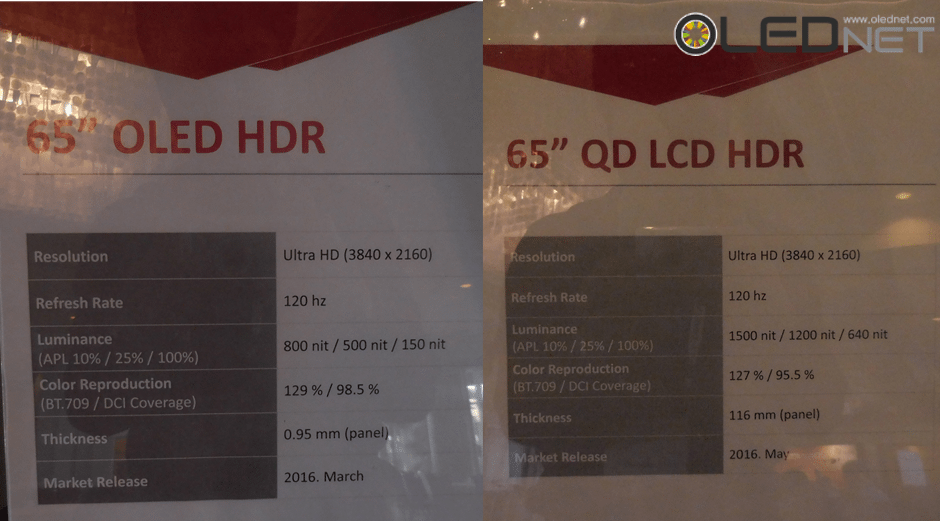
It presented in a way to compare various picture qualities of OLED TV and QD-LCD TV through various films and patterns such as normal TV program and movies.
LG Display personnel said, “OLED TV absolutely expresses black better than QD-LCD TV if OLED TV and QD-LCD TV set the mode that expresses white color 6500K which is the standard of UHD Alliance. Basically, the brightness of QD LCD TV is higher than OLED TV, but because the basis is LCD, it feels more distortion because of more white tone compared to the color of OLED TV. Also, OLED TV can almost express without distortion even in viewing angle, but the color is distorted in QD-LCD”, emphasizing better quality of OLED TV than QD-LCD TV.
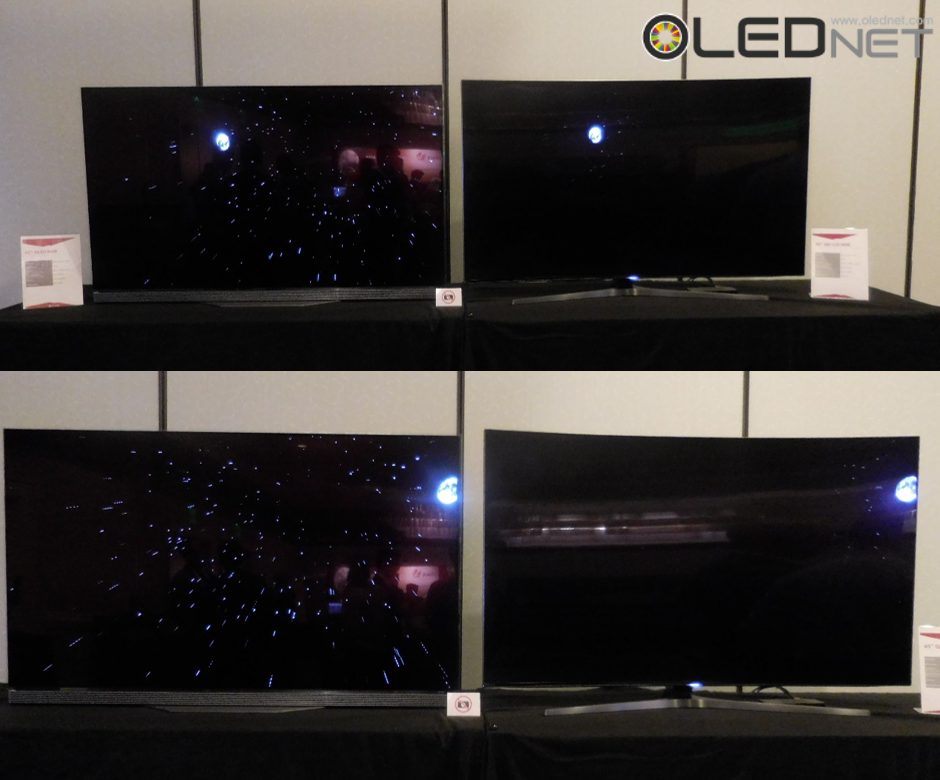
< Comparisons of 65inch OLED TV(Left) and 65inch curved QD-LCD TV’s Black Expressiveness >
Comparing the two pictures similar to images of space show below at the exhibition, OLED TV shows individual stars accurately while QD-LCD TV presents the stars vaguely just to indicate them. In the aspects of viewing angle, OLED TV nearly didn’t have any left-right color changes but its changes were found in QD-LCD TV.
Previous SID2016’s Nanosis and QD vision, Samsung and Hisense emphasized that QD-LCD is better than OLED TV in IFA 2016, but in this OLED Summit 2016, LG Display showed that OLED TV is much more outstanding compared to QD-LCD TV.
Like this, the position between QD-LCD TV and OLED TV is becoming more competitive, and the industry has the interest in which type of TV will gain more of customer’s trust.
Samsung Electronics TV Booth displayed in IFA2016 is very different from before. There are two types of LCD TVs in the market currently: the existing TV using LED BLU, and SUHD TV that uses quantum dot sheet. However, the product that was introduced and occupied a lot of booth exhibition space was the inorganic TV that uses quantum dot display, a product with unclear release date.
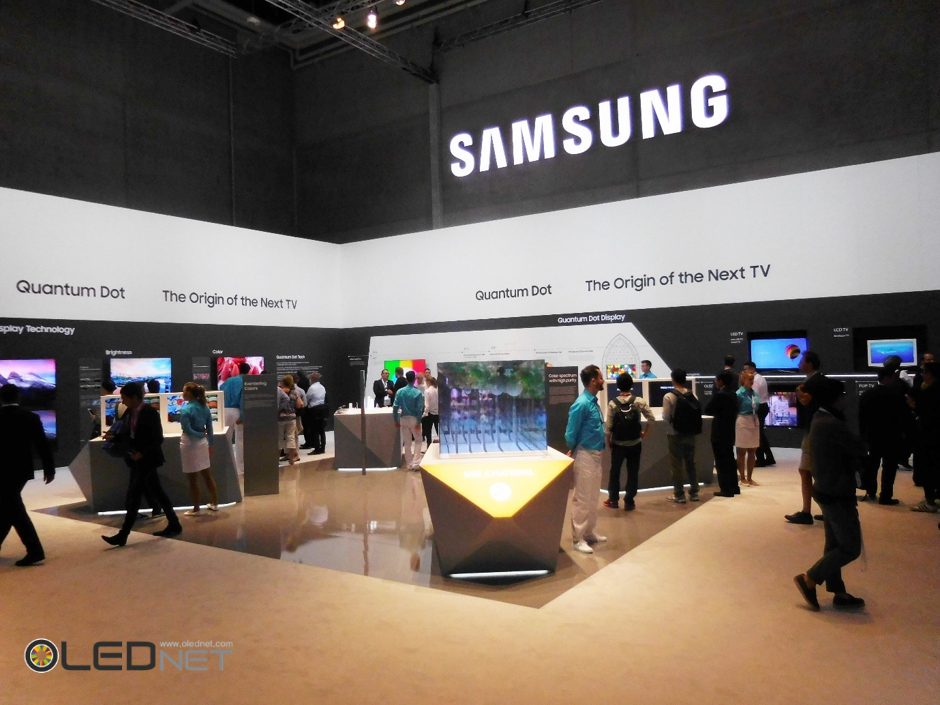
The conceptual inorganic TV that Samsung Electronics introduced instead of actual TV product is a product that displays far superior performance to OLED TV. As time goes by, the “organic” that represents OLED TV loses its function as a TV due to its rapidly decreasing brightness, whereas “inorganic” does not undergo such changes. If this is true, it is an excellent product that may well be used forever.
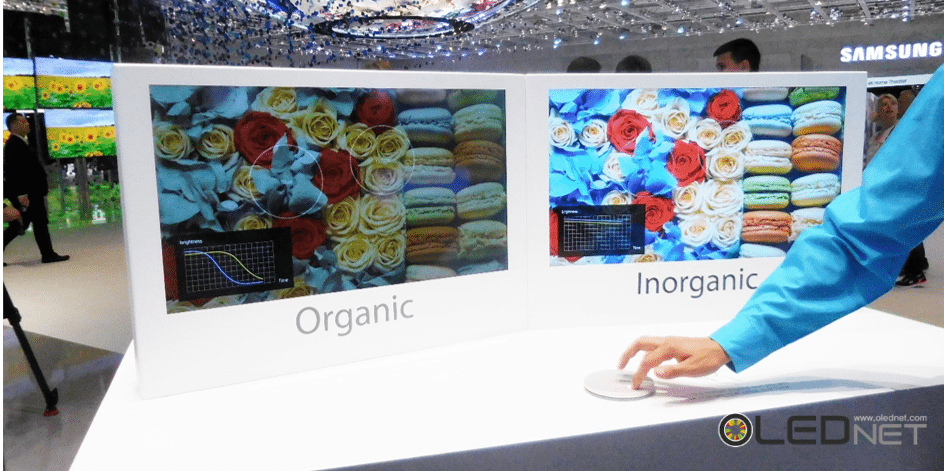
In another concept exhibition, Samsung Electronics introduced the superior color purity of Inorganic TV.
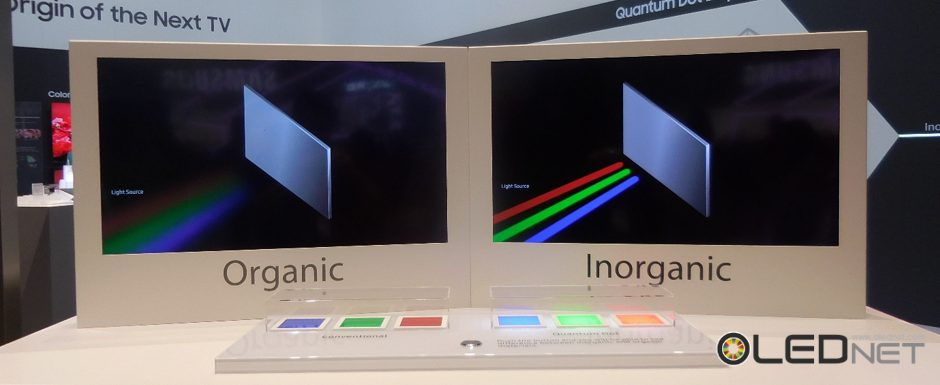
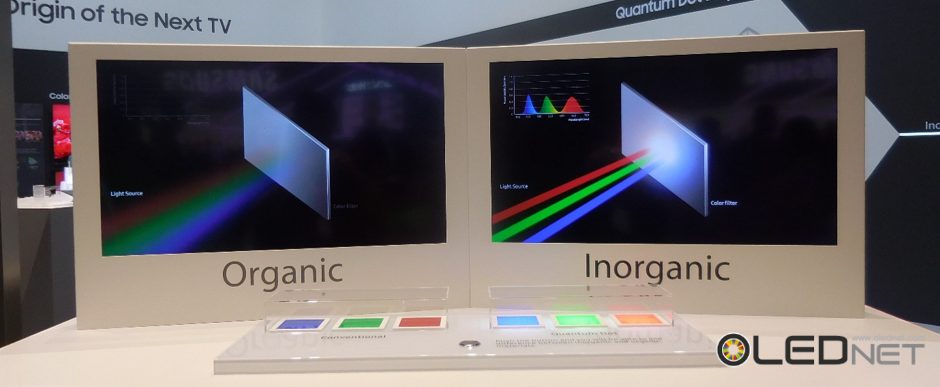
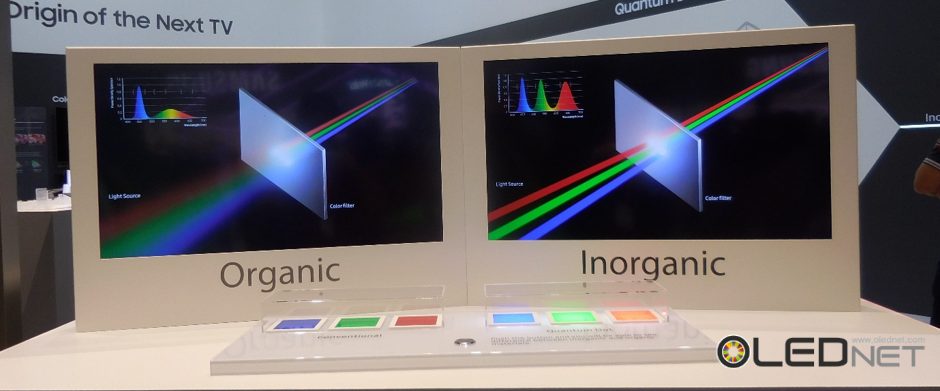
The light coming from the Organic TV light source has very vague RGB. In contrast, inorganic TV originates from clear RGB. Inorganic creates independent wavelength and intensity even before this light arrives at the color filter, whereas organic still displays a vague light with separated color.
The structure of inorganic TV seen from this is assumed to be a form in which a quantum dot substance is inserted between the screen and the color filter.
Finally, the light of organic, which goes through the color filter, lacks color purity of the three primary colors because it converts two-wavelength light with blue and green-red to three-wavelength.
However, even before arriving at the color filter, the light with superior color purity is emitted outside in inorganic.
If these two exhibitions are true, Samsung Electronics is preparing an incredible next-generation TV.
The problem pointed out by the participants is that this technology has not been born yet, and it is merely a concept. Samsung Electronics has described the unknown world with confidence, which is ironically viewed as if they are utterly unprepared for the future TV.
Moreover, by comparing OLED TV with a TV technology of the future instead of the SUHD TV currently in the market, they have indirectly admitted that OLED TV is better than the SUHD TV that uses quantum dot.
In IFA2016, Samsung Electronics wanted to show that SUHD TV will continue to grow and that OLED TV will disappear eventually. However, they have admitted that they are in an urgent situation in which, due to the superiority of OLED TV to the current SUHD TV, it cannot avoid being compared to the inorganic TV of the future.
Finally, whatever is done to LCD TV, black should be avoided, because it is LCD.
IFA2016에서 보인 삼성전자의 TV 부스는 이전과 매우 다른 점이 있다. 현재 시판 중인 LCD TV에는 LED BLU를 사용하는 기존 TV와 quantum dot sheet를 사용하는 SUHD TV 2종류이다. 그런데 부스 전시 공간 중 매우 넓게 차지하며 소개된 제품은 언제 나올지 알 수 없는 quantum dot display를 사용한다는 inorganic TV이다.

심성전자가 실제 TV 제품 대신 소개한 개념적인 inorganic TV는 OLED TV 보다 월등히 성능이 우수한 제품이다. OLED TV를 나타내는 “organic”은 시간이 지남에 따라 휘도가 급격히 떨어져 TV의 기능을 완전히 상실하지만 “inorganic”은 변화가 거의 없다. 이 내용이 사실이라면 영원히 사용할 수 있을 것 같은 우수한 제품이다.

또 다른 개념 전시 내용에서 삼성전자는 Inorganic TV의 색순도가 월등히 우수함을 알렸다.



Organic TV 광원에서 나오는 빛은 RGB가 아주 애매하다. 이에 비해 inorganic TV는 태생부터가 확실한 RGB로 시작한다. 이 빛이 칼라필터에 도착하기 전에 이미 inorganic은 독립적인 파장과 세기를 형성하였으나 organic은 여전히 색이 분리되지 않는 애매한 빛이다. 여기서 볼 수 있는 inorganic TV 구조는 액정과 칼라필터 사이에 quantum dot 물질이 삽입되는 형태일 것으로 추정된다. 마지막으로 칼라필터를 통과한 organic의 빛은 청색과 녹적이 섞여 있는 2파장 빛을 3파장으로 변환 시킨 것이어서 삼원색 색순도가 떨어진다는 것이다. 이에 비해 inorganic은 칼라필터 도달 전보다 훨씬 색순가 뛰어난 빛이 더 강하게 외부로 나가고 있다.
이 두가지 전시 내용이 사실이라면 삼성전자는 정말 엄청난 차세대 TV를 준비하고 있다.
문제는 이 기술은 태어나지도 않았고 엄마 뱃속에도 없는 완전 개념에 불과하다는 것이 전시장 참석자들의 지적이다. 뭐가 나올지 알 수 없는 미지의 세계를 너무 정확히 자신 있게 묘사한 삼성전자에 대해서는 역설적으로 미래 TV에 대한 준비가 전혀 되어 있지 않는 상황으로 보여지고 있다.
더욱이 OLED TV를 현재 시판 중인 SUHD TV와 비교하지 않고 미래의 TV 기술과 비교 함으로서 quantum dot을 사용하는 SUHD TV 보다 OLED TV가 우수하다는 것을 간접적으로 시인하고 말았다.
삼성전자는 IFA2016에서 SUHD TV가 지속 성장할 것임을 알리고 싶어 했고 OLED TV는 조만간 사라질 것이라고 표현하였으나, 오히려 OLED TV가 현재의 SUHD TV 보다 우수하기 때문에 미래에 만들어질 inorganic TV와 비교하지 않을 수 없는 급박한 상황인 것을 자인해 버렸다.
마지막으로 LCD TV에 무슨 짓을 해도 black은 안된다. LCD이기 때문에
2014년 CES2014에서 OLED TV는 아직 미흡한 기술이기 때문에 3년 정도의 개발 기간이 더 필요할 것이라는 언급이 있은 후 2년 반 뒤, IFA2016에서 삼성전자가 OLED TV 사업은 하지 않을 것이라고 강하게 피력했다.
최근 삼성전자는 한국 언론과의 인터뷰에서 OLED TV는 아직 화질에 문제가 많아 삼성전자는 수년 이내에 QLED TV로서 TV 사업을 지속할 것이라고 밝힌 바 있다.
IFA2016에서 TV의 과거와 현재, 미래가 어떻게 될 것인지 삼성전자의 속내를 공개했다.
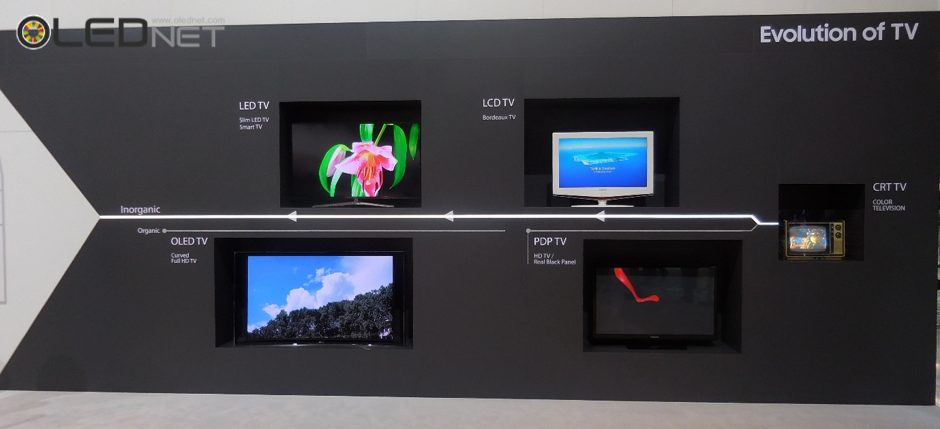
삼성전자 부스에 공개된 자료에 의하면 과거 LCD TV는 현재 LED TV로서 맥을 있고 있으며, 미래에는 inorganic 재료가 사용되는 quantum dot TV로 진화할 것이라고 밝혔다. 더불어 TV 시장에서 사라진 PDP TV와 마찬가지로 OLED TV는 curved FHD TV 수준에서 사라질 것이라고 표시했다.
이 자료로 볼 때 삼성전자는 타 LCD TV 세트 업체는 신경 써지 않고 오로지 LG전자의 OLED TV에만 모든 초점을 맞추고 있는 것으로 분석된다.
실제로 TV 시장 점유율 1위를 지키고 있는 삼성전자 입장에서는 premium TV 시장에서 세력을 확장하고 있는 LG전자의 OLED TV는 눈에 가시일 수 밖에 없다. 하지만 55인치와 65인치 UHD OLED TV가 잘 팔리고 있는 현 시점에서 볼 때 삼성전자의 전시 내용은 너무 나간 감이 없지 않다.
경쟁 업체에 대한 네거티브 공세는 마케팅 차원에서 허용 될 수 있지만 이번 전시에서는 도가 지나쳤다. 급기야 삼성전자는 아직 존재 하지도 않는 inorganic TV (Quantum dot TV)와 OLED의 내구성도 충실하게 비교 전시까지 하였다.
OLED TV는 시간이 지나면 색이 심각하게 변하지만 inorganic TV는 색 변화가 거의 없다는 내용이다.
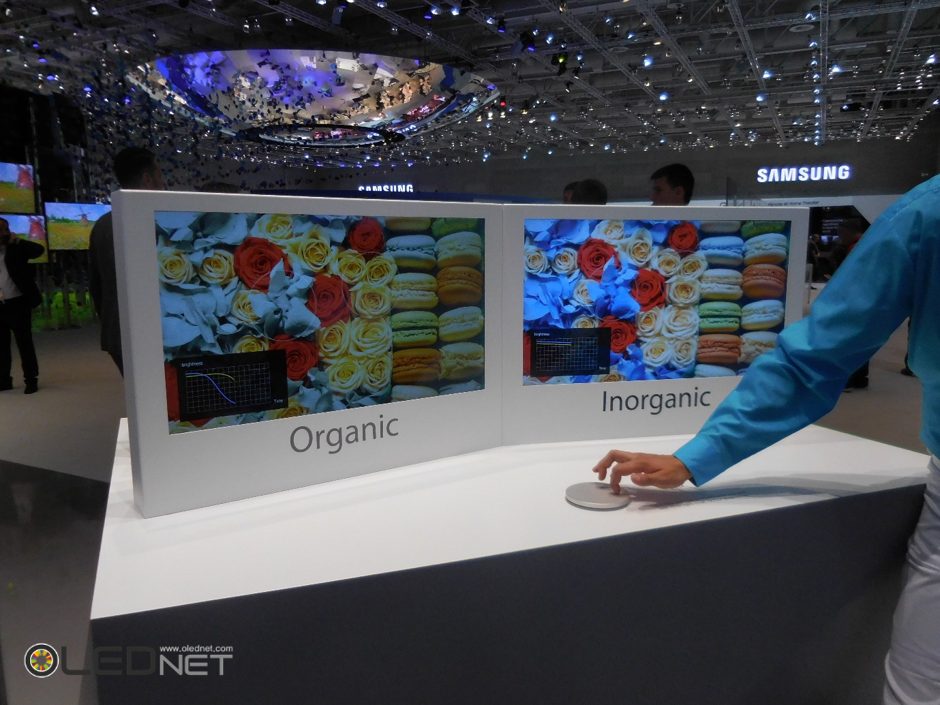
미국의 consumer report 사이트에는 하기와 같은 내용이 아직도 공개되어 있다. 2015년 “best TV 5”에는 LG전자의 OLED TV가 3종이나 있으며, 1위는 65인치 UHD OLED TV이다.
OLED TV의 종말이 삼성전자가 생각하는 만큼 빨리 오지는 않을 것 같다. OLED TV는 지금부터 시작이다.
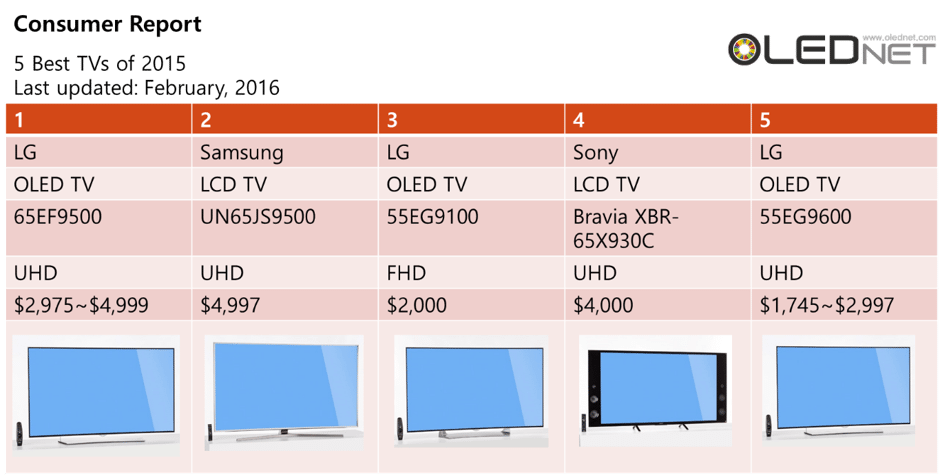
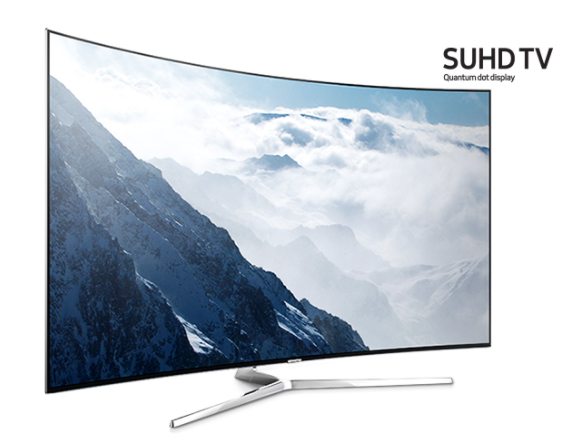
QLED TV 양산이 향후 5년간 쉽지 않을 것이란 전망이 나왔다. (Source = Samsung Elec.)

Samsung Elec.이 2016년 1Q 실적을 발표했다. (출처=삼성전자)
강현주 기자 / jjoo@olednet.com
삼성전자( Samsung Elec.)가 2016년 1분기 TV 판매 호조로 CE 사업 이익 개선을 달성한 반면 디스플레이 부문에서는 적자를 기록했다.
삼성전자는 28일 연결기준으로 매출 49조7800억원, 영업이익 6조6800억원원의 2016년 1분기 실적을 발표했다.
1분기는 ▲갤럭시S7의 조기 출시와 판매 호조, ▲메모리 고부가 제품 판매 확대, ▲시스템LSI 14nm 공급확대, ▲OLED 판매량 증가, ▲SUHD TV 등 프리미엄가전 판매확대 등을 통해 전년 동기 대비 매출은 5.7%, 영업이익은 12% 증가했다.
하지만 디스플레이 사업은 부진했다. 삼성디스플레이는 2016년 1분기 매출이 전년동기 대비 12% 하락한 6조400억원이며 영업이익은 전년동기보다 7900억원 하락한 -2700억원을 기록했다.
CE 부문은 SUHD TV와 커브드(Curved) TV 등 프리미엄 TV 판매 확대와 북미 중심 프리미엄 가전 판매 호조로 판매량이 증가해 전년동기 대비 실적이 큰 폭으로 개선됐다.
하지만 디스플레이의 경우 갤럭시S7 효과 등으로 OLED 실적이 개선됐지만, LCD의 경우, TV 패널 판가 하락과 신공법 적용 과정에서의 일시적인 수율 이슈로 실적이 감소했다.
LCD는 계절적인 비수기 수요 감소와 판매 가격 하락으로 전분기 대비 실적이 악화됐다. 반면 OLED의 경우, 신규 하이엔드용 패널 출시와 중가대 스마트폰 채용 확대에 힘입어 전분기 대비 실적이 개선됐다.
이 회사는 2분기에는 OLED 신제품 수요에 적극 대응하는 한편 고객 기반을 확대하고, UHD/초대형 등 프리미엄 LCD 판매를 강화해 실적 개선에 나설 계획이다.
삼성전자는 1분기 시설투자에 4조6000억원을 썼으며, 그 중 디스플레이 부문에는 1조8000억원을 지출했다.
2016년 디스플레이 시장은 OLED 패널 수요는 지속적으로 증가하지만, LCD 공급 과잉으로 전반적으로 시황이 어려울 것으로 예상된다.
하지만 플렉시블/고해상도 패널 증대로 OLED 실적 개선이 전망되며, LCD의 경우 하반기 시장의 수급이 개선되는 가운데, 고부가 제품 비중 확대를 통해 수익성이 좋아질 것으로 예상된다는 게 삼성의 설명이다.
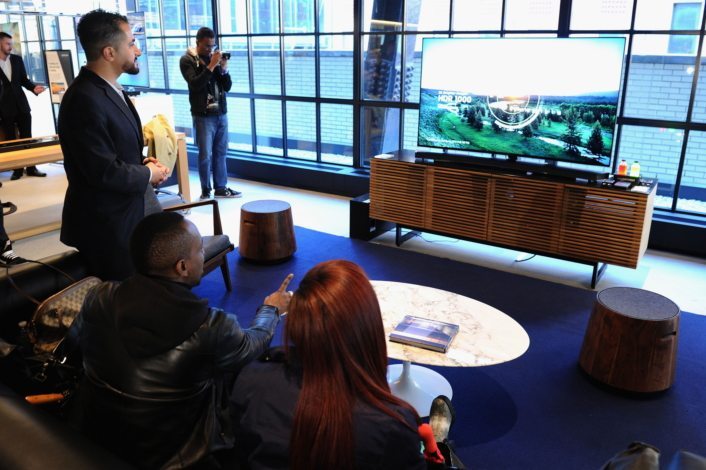
삼성전자가 뉴욕 마케팅 센터에 2세대 퀀텀닷 SUHD TV 등을 출시했다.(출처=삼성전자)
강현주 기자 / jjoo@olednet.com
삼성전자가 미국 뉴욕에 위치한 ‘삼성 뉴욕 마케팅센터’에 2세대 퀀텀닷 SUHD TV를 비롯한 홈엔터테인먼트 제품을 대거 출시, 북미 시장 공략에 나섰다고 14일 발표했다.
삼성전자는 올해 신제품 SUHD TV 전 라인업 뿐 아니라 UHD 블루레이 플레이어, 돌비 ‘애트모스’ 기술을 탑재한 사운드 바 등 홈 엔터테인먼트 신제품들을 출시했다.
삼성전자는 행사장을 거실, 침실, 서재 등 집안 곳곳의 생활 공간으로 꾸며 SUHD TV의 화질, 쉬워진 삼성 스마트TV 사용자경험(UX)을 마치 집에서 사용하는 것처럼 체험해 볼 수 있도록 구성했다.
올해 SUHD TV 신제품은 지난해보다 진화된 2세대 퀀텀닷 기술로 색상 표현이 25% 더 정확해져 자연색 그대로 표현하고, 전 제품에 1000니트(nit) 밝기의 HDR(High Dynamic Range)이 적용됐다.
TV 리모컨 하나로 TV와 TV에 연결된 케이블TV, IPTV, 인터넷 기반 동영상 서비스 등의 셋톱박스, 홈시어터, 블루레이 플레이어, 게임 콘솔 등 다양한 주변 기기들을 간편하게 제어하는 사용자경험(UX)이 참석자들의 큰 호응을 얻었다는 게 삼성전자의 설명이다.
터널 모양의 벽과 천정에서는 삼성전자가 세계 TV 시장 1위에 오르기까지 거쳐온 노력의 역사를 보여주는 영상으로 채웠다.
삼성전자는 2세대 퀀텀닷 디스플레이 SUHD TV를 북미시장에 성공적으로 출시해 11년 연속 세계 TV 시장 1위 수성의 초석을 다진다는 계획이다.
시장조사기관 NPD에 따르면, 삼성전자는 지난해 북미 평판 TV시장에서 금액 기준 37%의 점유율로 역대 최고 실적을 기록했다. 또한 지난해 북미 UHD TV시장에서는 52.7%의 압도적인 시장점유율로 1위를 차지했다.
삼성전자 미국법인 데이브 다스 상무는 “퀀텀닷 디스플레이가 선사하는 최고의 화질로 소비자들에게 TV의 새로운 가치를 제시하고 미국 TV시장을 선도해 나가겠다”며, “미국 소비자들에게 계속해서 사랑 받는 프리미엄 TV 브랜드가 되기 위해 노력할 것”이라고 말했다.
강현주 기자/jjoo@olednet.com
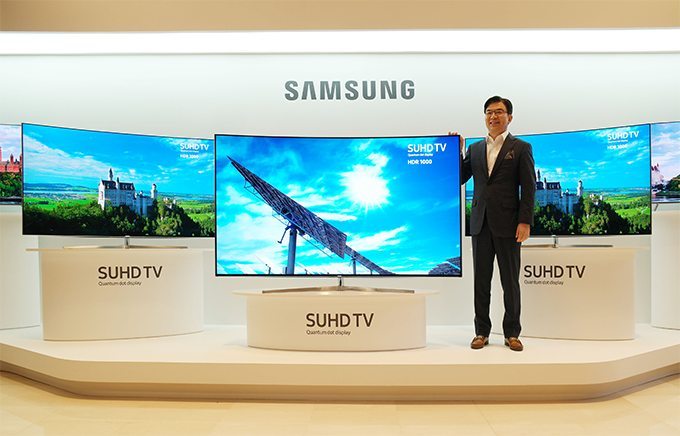
삼성전자가 2세대 퀀텀닷 TV를 출시했다. (출처=삼성전자)
삼성전자가 최근 국내 출시한 ‘2세대 퀀텀닷’ 디스플레이 탑재 SUHD TV 신제품에 대해 디스플레이 전문가들은 이 제품의 핵심 강점으로 ‘카드뮴 없는 1000니트 구현’을 꼽는다.
삼성전자는 지난 2015년 ‘나노 크리스탈 기술’이라는 명칭을 앞세워 퀀텀닷 SUHD TV를 첫 출시한 바 있다. 퀀텀닷 기술은 머리카락 굵기의 수만분의 1인 나노 크기의 퀀텀닷 입자 하나 하나가정확한 색을 표현해준다.
올해 신제품은 작년 제품보다 성능을 향상시킨 2세대 퀀텀닷 기술을 채용했다는 게 삼성전자의 설명이다. 전작보다 가격은 낮추고 밝기는 개선했다고 이 회사는 강조한다.
특히 이번 신제품은 전 모델에 최대 1000니트(nit) 밝기의 HDR(High Dynamic Range)을 채용했다.
1000니트 밝기는 미국 할리우드 영화사에서 제작한 프리미엄 영상의 표준이 되는 수치다. 이 수치가 높으면 거실처럼 밝은 장소에서도 화면의 밝고 어두운 부분을 세밀하게 감상할 수 있다.
삼성의 1세대 퀀텀닷 SUHD TV의 경우 전모델 적용은 아니지만 1000니트가 적용된 다수의 모델들이 있었던 만큼, 이번 신제품에 적용된 1000니트라는 수치 자체가 괄목할만한 것은 아니다.
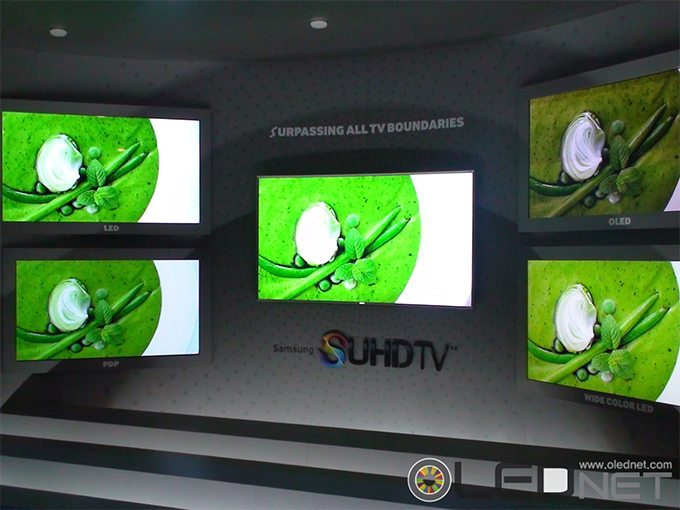
OLEDNET이 다녀온 CES 2015에서 삼성전자가 발표한 1세대 퀀텀닷 TV. 타 디스플레이와의 비교 전시.
◆유해 중금속 카드뮴, 왜 빼기 힘든가?
카드뮴은 퀀텀닷 필름 내 포함된 성분이다. 카드뮴은 유해성이 있는 중금속이기 때문에 카드뮴이 포함된 퀀텀닷 필름은 친환경적이라 할 수 없다. 실제로 유럽에서는 카드뮴 사용을 규제한다.
하지만 카드뮴을 제거할 시 필름의 광효율이 떨어지기 때문에 이를 보완하기 위해 다수의 LED 칩을 탑재해야 하는데 그럴 경우 가격이 높아지며 전력 소모도 증가한다. 이를 피하기 위해서는 효율을 높여주는 퀀텀닷 재료를 추가적으로 개발하는 방법이 있다.
이 때문에 퀀텀닷 디스플레이 탑재 제품을 생산하는 일부 중국 업체들은 친환경성을 포기하더라도 카드뮴 탑재를 선택하기도 한다.
삼성전자 관계자도 “카드뮴이 없는 친환경 퀀텀닷 소재를 사용하는 것은 자사가 유일하다”고 강조한다.
이 회사는 퀀텀닷 소재의 효율 향상 및 컬러 맵핑 알고리즘 개선을 통해 카드뮴 없이도 전력 소모량 증가 없이 1000니트의 밝기를 구현했으며 퀀텀닷 디스플레이의 특징인 색상의 정확도 25% 향상 효과도 놓치지 않았다.
한편 삼성전자는 올해 국내시장에서 49형부터 최대 88형까지 SUHD TV 총 14개 모델을 출시할 계획이다. 이는 지난해보다 30% 이상 늘린 것이다. 가격도 전작 대비 최대 90만원까지 내렸다. 신제품은 사양에 따라 65형은 600만원대, 55형은 400만원대다.
디스플레이 업계 한 전문가는 이번 삼성전자의 신제품에 대해 “1000니트라는 수치 자체에 큰 의미를 두긴 힘들며, 색상의 정확도 향상 역시 퀀텀닷의 본래 특성이라 주목할만한 사안은 아니다”라며 “단 퀀텀닷 디스플레이의 광효율을 높여주는 카드뮴을 사용하지 않고도 1000니트 밝기를 구현하고 전력효율도 무너뜨리지 않았다는 면은 평가할 만 하다”라고 분석했다.
Quantum dot 소재에 대한 관심이 날로 높아지고 있다. 작년 7월 서울대학교 이창희 교수는 QLED의 성능과 수명을 획기적으로 높이는 기술로 이 달의 과학기술자 상을 수상하였으며, CES 2016에서 삼성전자는 카드뮴이 들어있지 않은 quantum dot를 채용한 제품인 SUHD TV를 통해 UHD TV의 표준 색영역인 BT.2020을 달성하며 큰 화제를 모았다.
이러한 관심에 대해, 14일 서울시립대 곽정훈 교수는 서울 여의도에서 열린 ‘디스플레이 산업 위기 극복을 위한 선도기술 세미나’에서 “Quantum dot 기술은 장기적인 관점에서 충분한 가능성을 가진 소재이다.”라고 전망했다.
Quantum dot 소재는 먼저 blue LED와 함께 쓰여 LCD의 색재현율을 높이는 데 활용될 수 있다. 이 때 quantum dot을 측면에 배치하는 edge형과 quantum dot 필름을 BLU앞에 붙이는 surface 유형이 대표적으로 소니를 제외한 대부분의 TV메이커는 surface 형을 택하고 있다. 곽정훈 교수는 “Quantum dot은 재료를 바꾸지 않고 입자 크기를 조절하는 것 만으로 원하는 색을 얻을 수 있다.”고 밝히며 “이러한 특성을 통해 color filter 대신 쓰일 수도 있을 것으로 전망된다.”고 발표했다.
LCD의 색재현율을 높이는 것 외에도 quantum dot 물질은 유기 발광물질과 같은 원리로 전기를 흘리면 발광하는 특성을 갖고 있기 때문에 OLED 패널의 발광재료를 대체하는데 쓰일 수 있을 것으로 기대되고 있다. 업계에선 이를 QLED 혹은 QD-LED(Quantum dot Light Emitting Diode) 기술이라고 부른다. 곽정훈 교수는 “QLED는 OLED보다 색재현율이 좋으며 특히 deep blue 표현력이 좋다는 장점을 가지고 있다.”고 강조하며 “QLED는 기본적으로 용액공정을 통해 형성되기 때문에 용액공정에 대한 픽셀 패터닝 기술이 개발되어야 하며 소자의 수명도 더 길어져야 한다.”고 밝혔다.
곽정훈 교수는 QLED 소재는 현재 대량 생산 하는 곳이 거의 없어 단가가 높게 형성되어 있지만 합성이 쉽다는 장점이 있기 때문에 장기적인 관점에서 OLED 보다 상대적으로 낮은 단가로 사용하는 것이 가능하다고 강조했다.
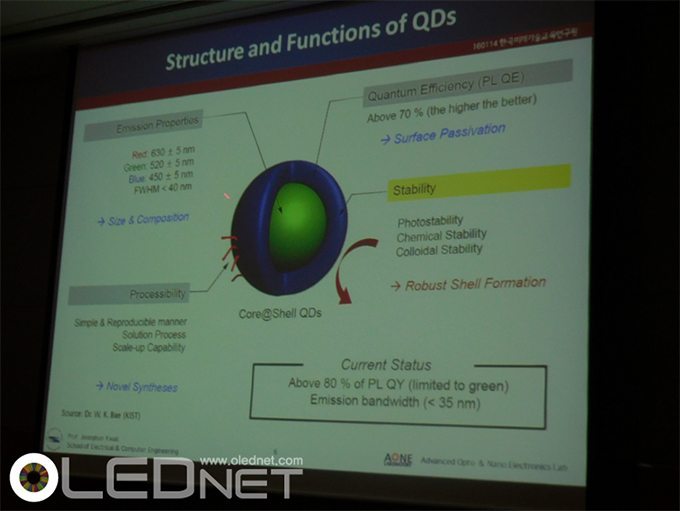
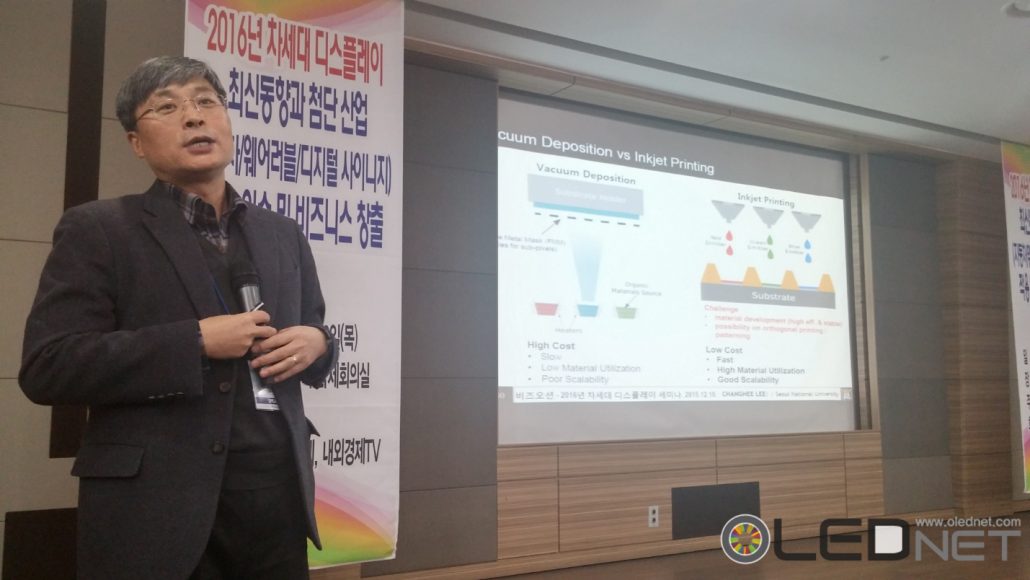
지난 10일 세미나 전문 기업 비즈오션이 주최한 ‘2016년 차세대 디스플레이 최신 동향과 첨단 산업적용 이슈 및 비즈니스 창출 세미나’가 한국기술센터에서 열렸다. 이날 처음 발표자로 나온 서울대학교 이창희 교수는 OLED가 미래의 디스플레이 기술이 될 것이기 때문에 업체들의 투자가 필요한 시점이라고 발표했다.
이창희 교수는 ‘디스플레이는 카메라의 해상도를 따라간다’고 말하며 UHD 해상도까지 개발된 상태지만 앞으로 더 높은 해상도로 갈 것을 전망했다. 더 높은 해상도로 갈수록 고객이 요구하는 디스플레이 성능은 높아질 것이라는 말도 덧붙였다.
현재 디스플레이 시장상황에 대해 이 교수는 ‘LCD는 마진이 떨어지고 있어 OLED로 시장을 개화해야 하지만, 아직 비싸고 capa가 적다’고 말했다. 또한 고객들이 삼성의 AMOLED 스마트폰에서 ‘‘액정이 나갔다’라는 말을 쓰는 것을 보면 아직 LCD와 OLED를 구분하지 못하는 것 같다’고 말하며, ‘OLED의 특성을 살린 투명, 플렉서블 디스플레이로 LCD와의 차이점을 알리고, 차별화 전략으로 시장을 열어야 한다’고 발표했다.
이창희 교수는 미래의 디스플레이로 프린팅 OLED를 꼽았다. 이 교수는 프린팅 OLED에 대해서 ‘프린팅 OLED는 진공증착보다 특히 청색의 수명이 떨어지지만 2~3년 후면 상용화 단계에 오를 것’이라고 말했다. 아직 재료 측면에서 보면 부족하지만 제조 원가 절감과 빠른 tact time, 재료 사용 효율 등의 장점이 시장을 개화할 수 밖에 만들 것이라고 덧붙였다. 이러한 이유 때문에 삼성과 LG에서도 개발을 진행하고 있다.
이창희 교수는 LCD는 산업 주기 중 성숙기로 당분간 시장을 주도하지만 OLED 기술이 빠르게 발전하여 차세대 디스플레이 시장의 주역이 될 것으로 전망했다. OLED TV는 가격 경쟁력을 확보하기 위해 프린팅 기술을 바탕으로 한 대면적 OLED의 양산이 시급한 점을 언급했다. 현재 OLED의 capa가 LCD에 비해 100분의 1도 안되어 수요량이 있어도 공급이 따라가지 못할 수 있기에 업체들에게 투자의 필요성을 제기했다. 고객의 수요가 많으나 공급이 적으면 시장 개화의 지연이 있을 것이라고 덧붙였다.
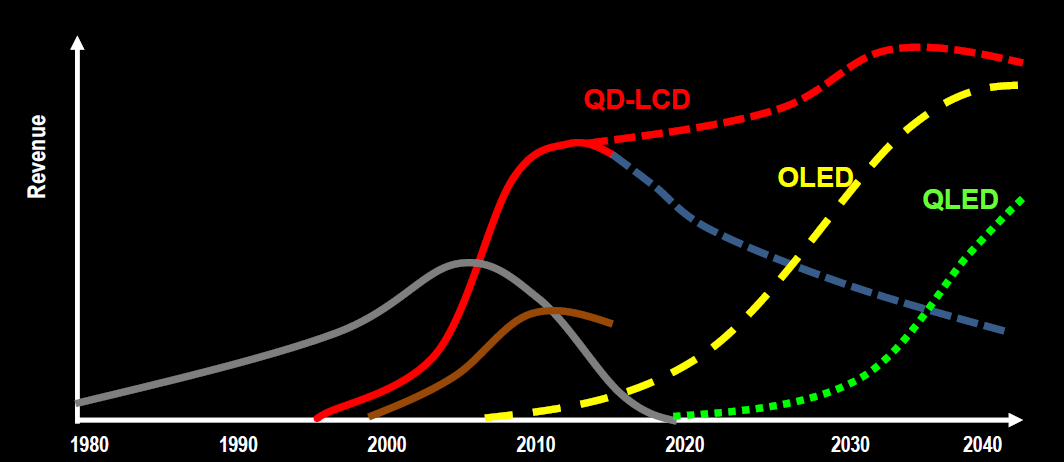
< Display 시장 전망 [출처 : 이창희 교수 발표자료]>
One of the reasons that OLED lighting is not becoming commercialized, despite its diverse advantages compared to other lightings, is its high price. The most fundamental way to reduce OLED lighting panel cost is investment in OLED lighting panel mass production line. Price reduction for components and materials is also an important factor.
The OLED lighting panel that is currently being mass produced has red/green/blue or yellow/blue stack structure. Also the use of tandem structure of more than 2 stacks to increase efficiency makes the process complex, lowers the yield, and increases the amount of materials used, and is becoming a key factor in increasing the production cost.
At LED/OLED Expo 2015, Cheorwon Plasma Research Institute (CPRI) displayed technology that produces white by applying light extracting film that contains red and green quantum dot (QD) material on blue OLED. CPRI forecasts that this technology of QD film applied blue OLED will be the solution for lowering OLED lighting panel production cost.
CPRI’s senior researcher Yong Hwan Yoo explained, “When QD light extracting film is applied to blue OLED, the evaporation processes are reduced compared to existing RGB or YB tandem structure OLED lighting. This could lead to production cost reduction as the yield increases and material cost decreases. If the QD purity improves, as well as blue material’s lifetime and efficiency, it is anticipated that the efficacy will match that of RGB or YB tandem OLED lighting panel.”
CPRI exhibited LED caps to be used for mascots at the opening/closing ceremonies of PyeongChang 2018 Winter Olympics, ultimately aiming for manufacturing them using OLED lighting panel instead of LED.
OLED lighting이 다른 조명들에 비해 다양한 장점을 가지고 있음에도 불구하고 상용화 되지 못하고 있는 이유 중 하나는 높은 가격이다. OLED lighting panel의 가격을 낮출 수 있는 근본적인 방법은 OLED lighting panel 양산라인 투자이며, 그 밖에 부품과 재료에 대한 비용 절감도 중요한 요소이다.
현재 양산중인 OLED lighting panel은 red/green/blue 또는 yellow/blue의 적층 구조로서 양산되고 있다. 또한 효율을 높이기 위해 2stack 이상의 tandem 구조를 적용하는 방법이 사용되어 공정이 복잡해지고 수율이 낮아지며 재료사용량이 증가하는 등 원가 상승의 핵심 요인이 되고 있다.
LED/OLED Expo 2015에서 철원 플라즈마 산업기술연구원(CPRI)는 blue OLED에 red와 green QD(quantum dot) 재료를 포함한 광추출 film을 적용하여 white를 구현하는 기술을 선보이며 QD film을 적용한 blue OLED가 OLED lighting panel의 원가절감 솔루션이 될 수 있을 것으로 내다봤다.
CPRI의 유용환 선임연구원은 “Blue OLED와 QD 광추출 film을 적용하면 기존의 RGB또는 YB tandem구조의 OLED lighting보다 증착 process가 감소하기 때문에 수율이 상승하고 발광재료 사용비용이 줄어들어 원가절감이 될 수 있다. QD의 순도가 개선되고 blue material의 수명과 효율특성이 개선된다면 RGB 또는 YB 적층의 OLED lighting panel만큼의 효율도 가능할 것으로 기대된다.” 라고 밝혔다.
CPRI는 2018년 평창 동계올림픽의 개/폐회식 때 마스코트용으로 활용하기 위한 LED 모자를 전시하였으며, 최종적으로는 LED 대신 OLED lighting panel로서 제작하는 것을 목표로 개발 중에 있다.
South Korean research team lead by Professor Changhee Lee in Seoul University succeeded in making first quantum dots that emit ultraviolet light and used them to produce a flexible, light-emitting diode.
UV light is usually produced by mercury lamps or LEDs made from inorganic materials such as gallium nitride (GaN). However, mercury lamps tend to emit a wide range of visible wavelengths as well as UV, and high-performance gallium nitride LEDs are expensive to make. According to Professor Lee, quantum dots are an attractive alternative which can be made using potentially less expensive solution-based processes.
Quantum dots, made out of a semiconductor material, emits different wavelengths depending on the size and shapes. The smaller the crystal, the shorter the wavelength of the light it emits. The Professor Lee’s team is the first in succeeding in making quantum dots that emit wavelengths shorter than about 400 nm, the high end of the UV spectrum.
In order to produce UV nanocrystals, the team had to figure out how to make quantum dots with light-emitting cores smaller than 3 nm in diameter. To make these, the team utilized cadmium zinc sulfide, which emits high-frequency light, zinc sulfide shell. The quantum dots produced through this method emit true UV radiation at about 377 nm. Professor Lee explained that they “can go to much shorter wavelengths than people generally expected from quantum dots”.
The research group then made a flexible LED with the quantum dots, using a design for a high-efficiency device they developed in 2012. Professor Lee’s team showed that the UV LED could illuminate an anticounterfeiting mark in a bill of paper currency. Franky So, a materials scientist at the University of Florida, says making a device out of the quantum dots that shines brightly enough to reveal the currency mark is a remarkable accomplishment. If their lifetimes can be improved, these potentially low-cost UV LEDs could find uses in counterfeit currency detection, water sterilization, and industrial applications.
The research team headed by Professor Lee includes Seoul National University, Professor Seonghoon Lee and Professor Koonheon Char, and Dong-a University’s Professor Jeonghun Kwak. The research was published in Nano Letters (Nano Lett. 2015, DOI: 10.1021/acs.nanolett.5b00392), a monthly peer-reviewed scientific journal, and reported on Chemistry & Engineering (27 May), published by the American Chemical Society.
서울대 이창희 교수팀은 서울대 화학생물공학부 차국헌 교수와 화학부 이성훈교수, 동아대학교 전자공학과 곽정훈 교수와의 공동연구를 통해 세계 최초로 양자점을 이용하여 순수한 자외선을 발광하는 고출력 양자점 발광 다이오드 개발에 성공 하였다.
UV light는 보통 mercury lamp나 갈륨질소 화합물과 같은 무기물로 만들어진 LED를 이용하여 제작되었다. 그러나 mercury lamp는 UV 이외에 넓은 범위의 가시광 파장까지 방출하며, 갈륨질소로 제작된 LED는 제조가격이 높다. 서울대 이창희 교수는 “Quantum dot LED(QLED)는 저비용의 solution process를 적용하여 제작할 수 있어 매력적인 대안이 될 수 있다.”라고 밝혔다.
반도체 재료로 만들어지는 quantum dot은 크기와 모양에 따라 다른 파장을 방출하며, crystal의 크기가 작을수록 빛을 내는 파장은 더 짧아진다. 이교수 팀은 세계 최초로 RGB 가시광선 영역을 넘어서 자외선 영역까지 발광하며, 400nm 보다 짧은 파장의 quantum dot 개발에 성공하였다.
이 교수팀은 UV nanocrystal을 제작하기 위해 고효율의 빛과 zinc sulfide shell을 가진 cadmium zinc sulfide를 활용하여 지름이 3nm보다 작은 light-emitting core를 가지고 377 nm의 true UV 방사선을 방출하는 quantum dot을 만들었다. 이창희 교수는 “우리는 사람들이 quantum dot에 일반적으로 기대하는 파장보다 훨씬 더 짧게 만들 수 있다”고 말했다.
이교수 팀은 2012년에 고효율의 구조와 quantum dot을 적용한 flexible LED를 개발한 바 있으며, UV LED가 화폐의 위조방지 마크를 비출 수 있다는 것을 보여준 바 있으며, 플로리다 대학의 Franky So는 quantum dot으로 위조지폐를 감별할 수 있을 정도로 밝게 빛나는 소자를 제작하는 것은 괄목할 만한 성과라고 밝힌 바 있다. Quantum dot의 수명이 입증될 수 있다면 위조 지폐 감지와 산업 응용분야에 쓰일 수 있는 낮은 가격대의 UV-LED로 사용 될 수 있을 것으로 전망된다.
이 연구 성과는 저명 나노과학 학술지인 Nano Letters (Nano Lett. 2015, DOI: 10.1021/acs.nanolett.5b00392)에 게재되었으며, 미국 화학회에서 발행하는 Chemistry & Engineering News 5월27일자에 최신 뉴스로 보도되었다.
Professor Changhee Lee of Seoul National University discussed QLED’s future in the 1st OLED KOREA Conference (April 2), organized by UBI Research.
QLED is a display that replaced emitting layer’s host and dopant to quantum dot (QD) whilst continuing to use existing OLED’s common layer, and can be formed via solution process. It can be mistaken as similar concept with recently released quantum dot products. However, these are devices that have quantum dot film attached to LCD and therefore fundamentally different from QLED which has basis on OLED.
Of the OLED panel cost, the expensive OLED key emitting layer materials, host and dopant, take up a high percentage. On the other hand, OLED’s emitting material quantum dot uses inorganic material which is cheaper compared to OLED material. This means that the QLED panel can be more reasonably priced, a point of great interest for the industry.
However, in order for QLED to be practical there are several issues that need to be solved. Balancing the electrons and holes, and prevention of pin holes that occur in each layer is a key technology needed to increase QLED’s efficiency that is quickly being developed. Also, although cadmium used in QLED is not likely to affect the environment, considering future environmental regulatory concerns quantum dot without cadmium is being researched. Lastly, solution process technology has to be established.
If QLED overcomes these issues and its lifetime and efficiency can match those of existing OLED, it is estimated QLED applied products will be manufactured. Professor Lee forecast that QLED would bring positive results of bringing down the cost of display while maintaining most of existing OLED process; QLED uses cheaper quantum dot material for emitting layer whilst continuing to use equipment and common layer of existing OLED technology. Additionally, he also concluded that there will not be any problem for material companies as they will be able to carry on selling materials for quantum dot. Professor Lee went on to ask OLED related companies with anti-QLED views to accept QLED in the same flow as OLED, and for positive considerations.
서울대학교 이창희 교수는 유비산업리서치 주관으로 2일 열린 제1회 OLED Korea Conference에서 QLED의 미래에 대한 발표를 하였다.
QLED란 기존 OLED에 사용되는 공통층을 그대로 사용하면서 발광층의 Host와 Dopant를 Quantum Dot(양자점)으로 바꾼 디스플레이로서 solution process로 형성이 가능하다. 최근 공개된 Quantum Dot 제품들과 비슷한 개념으로 오해할 수 있지만, 이런 제품들은 LCD에 Quantum Dot 필름을 부착한 제품으로서 OLED에 기본을 둔 QLED와 근본적인 원리가 다르다고 할 수 있다.
OLED의 핵심 발광층 재료인 host와 dopant는 비싼 가격으로 인해 OLED panel 가격에서 높은 비중을 차지하고 있다. 하지만 QLED에 사용되는 발광층의 재료인 Quantum Dot은 무기재료를 사용하여 OLED의 발광층 재료보다 가격이 상대적으로 저렴하기 때문에 panel 가격을 낮출 수 있다는 점에서 업계의 많은 관심을 받고 있다.
하지만 실제 QLED가 사용되려면 극복해야 할 몇 가지 이슈들이 있다. QLED의 효율을 높이기 위해서는 전자와 홀의 비중을 맞추고 각 Layer에 발생하는 핀홀을 방지하는 것이 핵심 기술로서, 관련 기술들이 빠르게 개발 중에 있다. 또한 QLED에 사용되는 카드뮴은 실질적으로는 환경에 영향을 줄 가능성은 거의 없지만, 향후 환경규제에서 자유로울 수 없기 때문에 카드뮴이 없는 양자점에 대한 연구도 계속 되고 있다. 마지막으로 solution process에 대한 공정 기술이 확보되어야 한다.
이러한 QLED의 이슈들을 극복하여 수명과 효율이 기존의 OLED와 비슷한 수준으로 오르게 된다면 QLED를 적용한 실제 제품이 개발될 것으로 예상된다. 이창희 교수는 QLED는 기존 OLED의 장비와 공통층을 그대로 쓰면서 발광층의 재료만 가격이 낮은 quantum dot 재료를 사용하기 때문에 기존 OLED 공정에 큰 변화를 주지 않으면서도 디스플레이 전체 가격이 낮아지는 긍정적인 효과를 가져올 것으로 전망하였다. 또한 기존의 재료업체의 경우 QD재료를 그대로 판매할 수 있기 때문에 문제가 없을 것이라고 발표하며 QLED에 부정적인 시각을 가진 OLED 관련 업체들에게 QLED를 OLED와 같은 흐름으로서 이해하고, 긍정적인 관심을 부탁한다고 당부하였다.
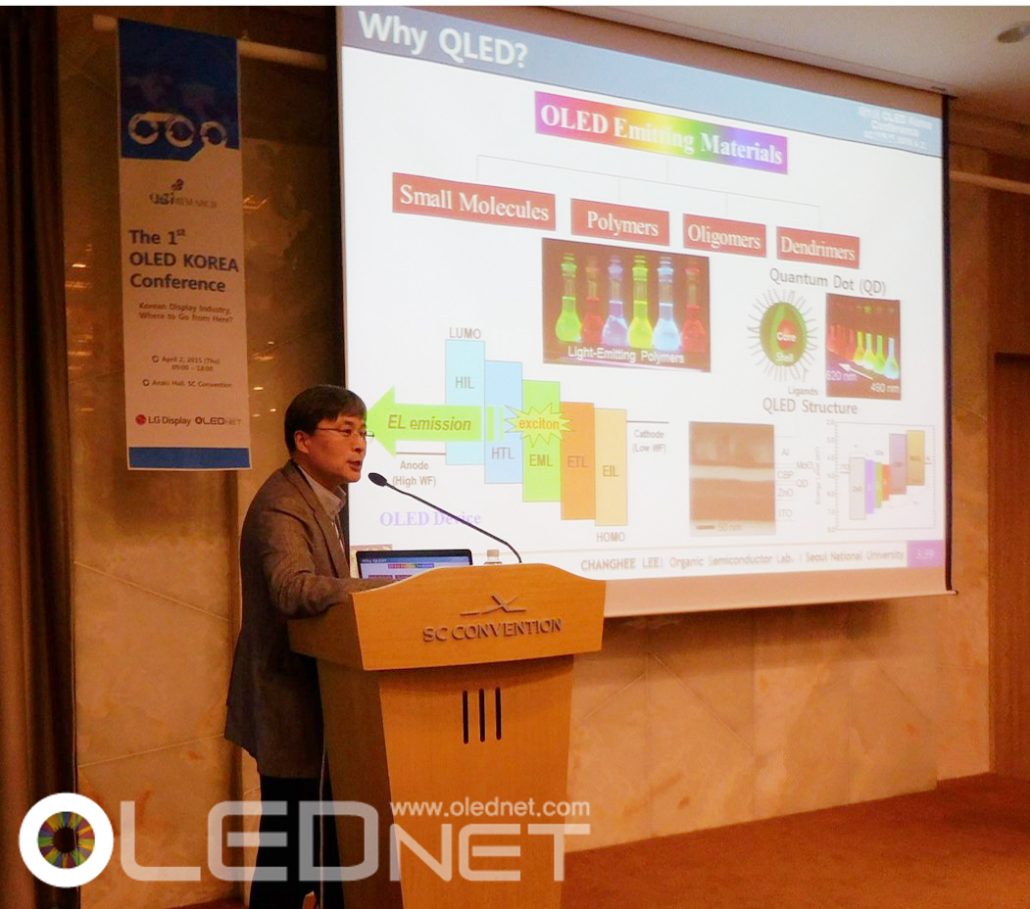
Prof. Changhee Lee, the 1st OLED KOREA Conference
LCD TV에 또 한번 대 혁신이 생겼다. Quantum dot(QD)을 사용한 LED BLU로서 LCD TV 화질은 이제껏 누구도 상상할 수 없는 궁극의 경지까지 도달했다.
CES2015에서 삼성전자를 비롯하여 LG전자, Sony, Sharp, TCL, Haier 등 TV 세트 업체들이 QD-BLU LCD TV를 공개했다. QD-LED로 인해 색재현율은 NTSC 110%까지 모두 도달하였으며, HDR(high dynamic range) 기술로서 휘도와 명암비가 이제까지의 LCD 패널에서는 볼 수 없었던 화려한 화질을 얻을 수 되었다. 기존 LCD TV는 명암비가 분명하게 나타나는 야경을 화면에 나타내는 전시는 거의 볼 수 없었으나 CES2015에서 삼성전자는 SUHD TV(상)와 기존 LCD TV와의 명암비를 직접 비교하는 전시로서 LCD TV가 얼마나 좋아졌는지를 보여주었다.
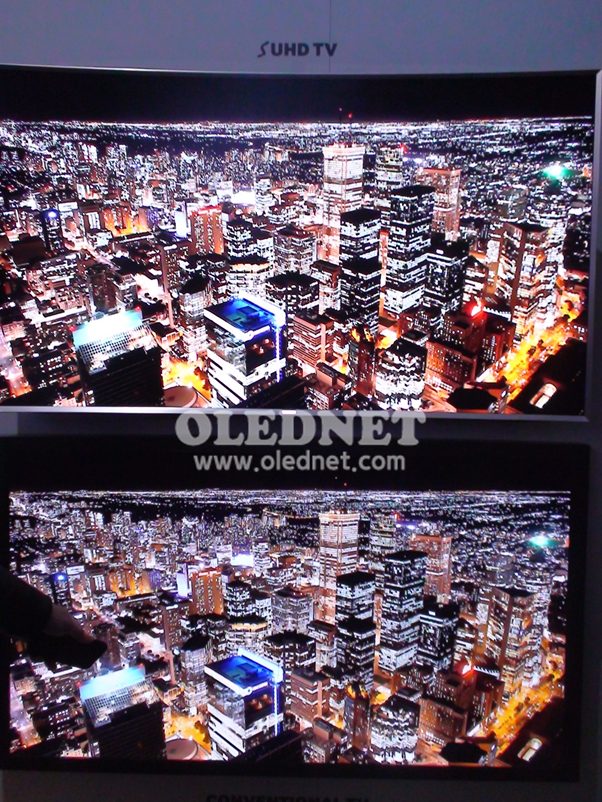
또한 외관에서는 curved와 10mm이하의 박형 디자인으로 기존 LCD TV와는 확연히 차이 나는 변화를 보여주었다. Wide color LCD는 시야각마저도 거의 자발광 수준에 도달했다.
도대체 LCD TV는 어디까지 진화할까?
이번 CES2015에서 답이 나왔다.
OLED TV까지이다.
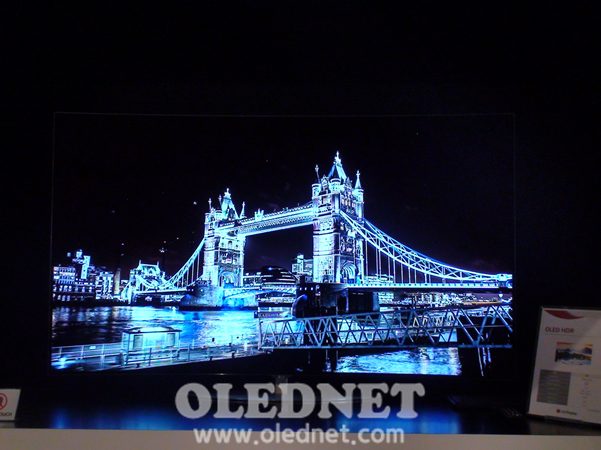
LG, 65inch OLED TV
OLED panel을 생산할 수 있는 업체는 전 세계에서 LG디스플레이가 유일하며, 현재 시점에서 OLED TV를 대량 생산할 수 있는 업체는 LG전자뿐이다.
OLED 패널이 가지고 있는 색재현성과 명암비, 응답속도, 시야각, 두께 등은 삼성전자가 생산하는 smart phone Galaxy series에서 이미 LCD 보다 월등히 우수함이 증명되었다. 따라서 OLED TV를 만들 수 없는 TV 업체들의 생존 수단은 OLED 패널을 대량으로 수급 할 수 있을 때까지는 어떻게 하든지 LCD TV를 최대한 OLED TV와 유사하게 만드는 것이다.
이번 CES2015에는 LCD TV가 할 수 있는 모든 기술이 총 동원되어 LG전자의 OLED TV 따라가기에 동원되었다. LCD TV는 색재현성과 시야각, 두께, 두꺼워짐에도 불구하고 휘어놓은 curved 디자인으로 OLED TV와 최대한 근접해졌다. 특히 HDR 기술로서 향상 시킨 명암비는 설명이 없으면 OLED TV로 착각할 정도로 좋아졌다. 하지만 LCD는 LCD이고 OLED는 역시 OLED이다. 흉내는 낼 수 있어도 같아 질 수는 없다.
OLED TV가 나옴에 따라 LCD TV가 다시 한번 변신하는 계기가 마련된 것은 TV 역사에서 바람직한 경쟁 사례로 길이 남을 것이다.
